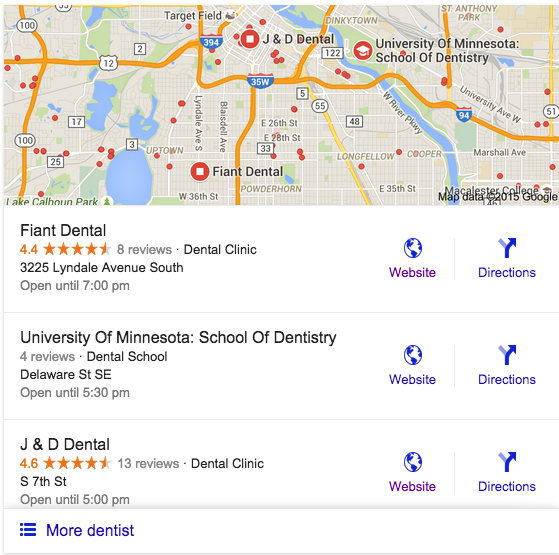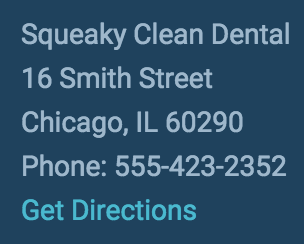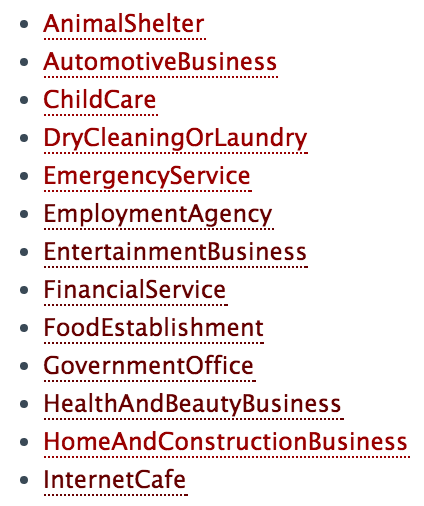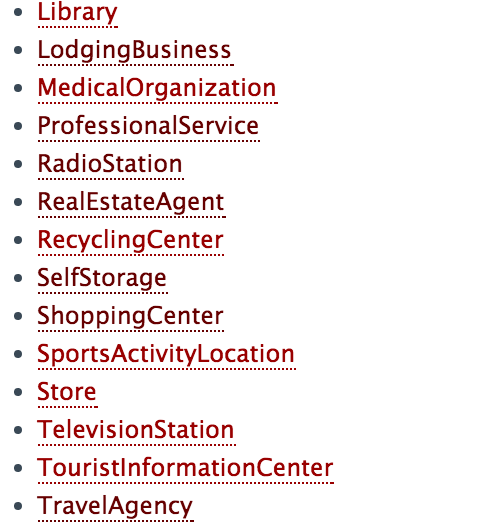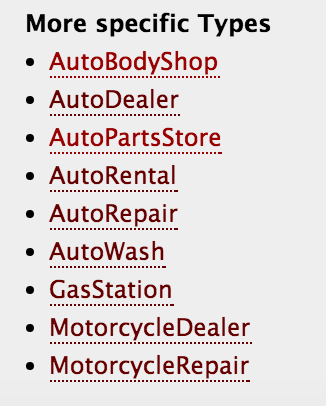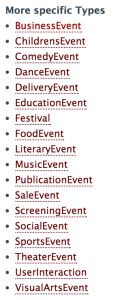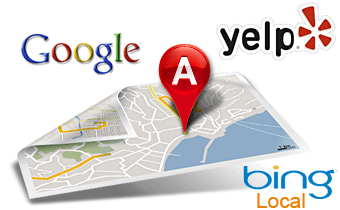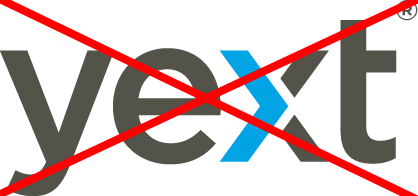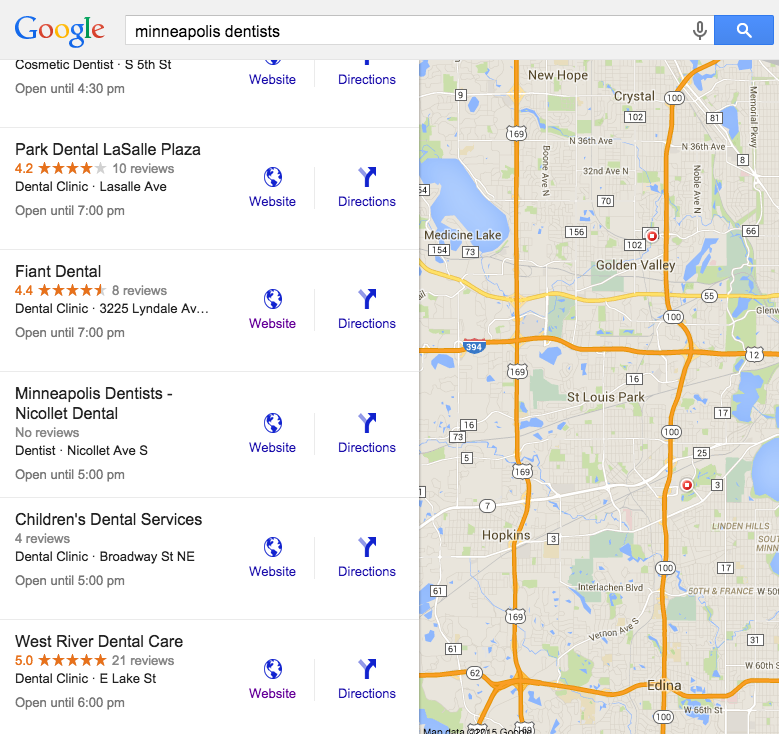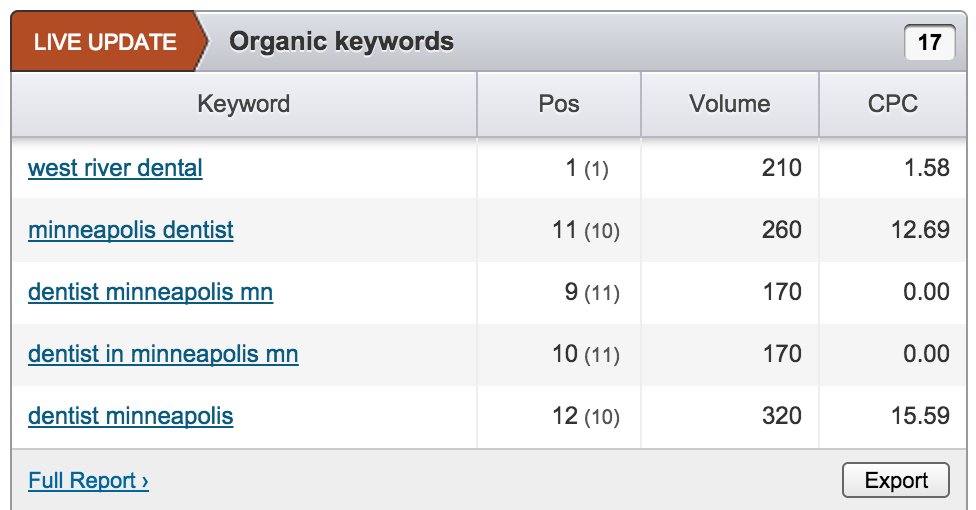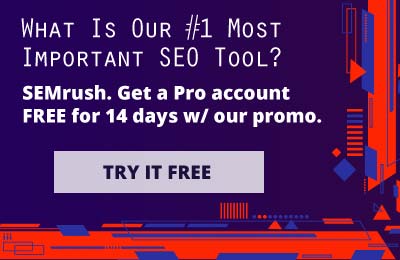Local SEO has become one of the most important and effective strategies for businesses to gain an edge against their local competitors.
Whether you own your own business or are an agency working with clients, having a definitive step by step Local SEO strategy is key to moving on up the local SERPs. With Google putting more emphasis than ever on local search, now is the time to act on reanalyzing your current Local SEO strategies if they are not working as planned and to implement a new plan of action.
There’s tons of great Local SEO resources out there, but none of them seem to give you that step by step walkthrough of what really needs to get done. That’s why I’ve compiled together this insanely actionable resource guide to help you through the process (and throw strategic tips your way).
If you’re looking for a Local SEO guide that combs through every resource out there and culminates step by step highly effective strategies, you’ve come to the right place.
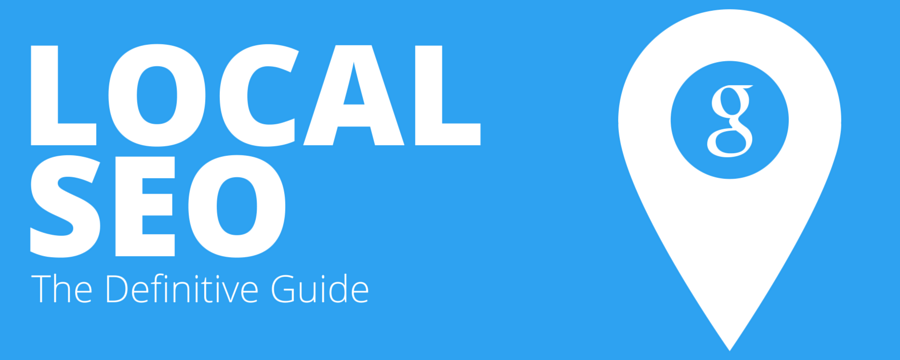
Table of Contents
- Prequel: A Little Intro to Get Started
- Chapter 1: Google My Business Page Optimization
- Chapter 2: On-Page Optimization of Website
- Chapter 3: Using Schema Markup Properly
- Chapter 4: Building Citations with Authority
- Chapter 5: Customer Review Strategies
- Chapter 6: Link Analysis Essentials
- Chapter 7: Competitive Analysis & Winning Strategies
- Chapter 8: Ultimate List of Local SEO Tools
Prequel: An Intro to get You Started
Let’s be real here, there’s always someone coming along saying they’ve got the “Ultimate Guide” to some topic. And in all honesty, most of the time it sucks. This compilation of information I’ve put together isn’t just from my own head. It’s a curated resource from every article I’ve read and digested for the past few years along with our agency’s own testing and experiences in working with clients.
And hey, if I missed something that you wanted covered..well just leave a comment, and we’ll get something in there on the topic! I want this to be the #1 resource for anything Local SEO related.
This isn’t just a guide to help complete beginners do all the work for their campaigns from now on. No, it should be a testament to how much real work needs to go into a Local SEO campaign in order for a business to have a shot at topping the local search results. Yes, this is for you business owners that are paying $250 a month to YellowPages thinking it’s going to help your business…

Please think again and consider hiring a legitimate Local SEO agency to help you if this isn’t your game. Yes it will be more expensive, but the ROI should always trump the expense.
Why should I conduct a Local SEO audit & analysis before getting started?
- To determine what elements on your website/landing page are poorly optimized or incomplete
- To gain an understanding of the current value your business brings to search results and how it can be improved
- To define the level of competition that you’re up against, and to get an idea of the amount of work it will take to best them
Make a plan before taking action. That’s what every person should be doing before actively going to town on a Local SEO campaign. Stick with me here and you’ll see why it’s just so important to thoroughly analyze a business’s local web presence before moving forward.
Who is this guide intended for?

I’m tailoring this guide to local business owners that want to try to do the basics themselves or agencies that have clients in need of local search services. As with many of the clients we handle, this tends to be focused on brick and mortar businesses that already have somewhat of a presence on the web, but need that boost to be in prime position in the Google SERPs.
Google’s local algorithm is always changing and what may work today, might not work tomorrow. However, this guide is meant to be as straight forward and white hat as possible. There will always be people that try to cheat and game the system, but let me be the first to tell you, they will get caught.
With that being said, take this audit as a first step before implementing the tactics and crushing it with results. Let’s get right into it!
So what does the Local SEO campaign process look like?
It should look like this:
- Complete the full Local SEO Analysis
- Analyze and Brainstorm the Best Plans of Attack
- Implement Desired Strategy
- Review Results over next few months
- If something isn’t working, head back to the drawing table and move to a new plan
Trial and error seems to be the key time and time again when it comes to finding the strategy that works best for your business. Google’s Local algorithms are always changing and with that you’re always going to have to adjust your approach.
That being said, as indicated in Casey Meraz’s awesome Local SEO audit write-up, unfortunately much of the work that needs to be done on business websites is cleanup work. We need to take into account the work of prior SEOs and old employees that have implemented what they thought were good SEO strategies back in the day, but now are more harmful to a business’s SEO than ever.
The main point here? Google became smarter. So should you.
Before You Start, Download the Audit Worksheet

Ugh, another worksheet? Yes. Another Worksheet.
We’ve reviewed each portion of this one several times and thoroughly believe it has all of the right questions to ask and answer. It doesn’t matter if you’re a business owner or an SEO agency, this info should be a priority before implementing your Local SEO campaign.
You need to know where you stand upon walking into this project. Which problems are evident? Which need a little more investigating? This reference sheet when filled out should put you in the proper place to begin your campaign.
Click to Open Up Local SEO Analysis Worksheet
Each tab in the spreadsheet should be addressed separately as you move through your own SEO analysis:
- Current NAP & Business Info
- Questions Needing Answers
- Competitor Analysis
- Citation Building
- Guide Checklist
Get it done.
Chapter 1: Optimize Your Google My Business Page for Success

Formerly known as Google Places, Google My Business is the new beginning point for all Local SEO audits. The My Business Dashboard contains a bundle of information that can help you get started on the right foot. More than that is making sure all of the information on the business page is accurate and follows Google’s business guidelines, as they tend to change rather often.
Update on August 7th: Google has officially detached Google+ pages from local results as you can see here:
Note the differences and how Google+ Links have been removed along with phone numbers. How will this affect rankings moving forward and this section in general?
It remains to be seen as Local experts test the results of this aftermath.
However, here are my thoughts before continuing:
- Filling out your Complete Google My Business Page IN FULL is still VERY important and will matter for rankings!
- It’s more important that ever to get your business NAP info correct, Categories, business hours and have clean images in your business profile.
- Even though Google is shying away from Google+, it’s still important for now to make sure your full Google + page is available and out there on the web.
Let’s dive into the Google My Business section.
1. Find Your Google My Business Page/Verify No Duplicate Pages
What to Do: Locating the actual My Business page that you’ll be working with is an obvious first step. Unfortunately many companies for some reason have had duplicates made over the years. If you’re working with a client, make sure you ask them for the primary page they’d like to use.
Once found, confirm and record the url, this will be your mainstay for a while. You’re still going to want to be 100% sure there are no duplicate My Business pages as this can be a threat to an entire Local SEO campaign. A great tool for finding potential duplicates that I use: This Google Places finder tool over at Michael Cottam’s site
I would also check by just heading over to https://plus.google.com/ and searching amongst the Google+ pages for the business name. This will return results if there were multiples as well. If you come across duplicates, make sure you note the primary page going forward and notify google to delete the others.

End Goal: Record the Primary Google My Business Page URL that all Local SEO work will be completed on moving forward. Find and destroy any duplicate pages that may currently be existing.
2. Page Verification
In order to continue with any of the next steps, we need to make sure the Google My Business listing is verified. You’re very limited on optimization options until this step gets completed, so that’s why I put it as top priority.
What to Do: If you haven’t claimed your business at all, you’ll want to find the google page associated and then click the “Is this your business?” text at the bottom where you’ll be taken through the claiming process. When you login to your business dashboard, if you look next to your business name there should be a checkmark with a “Verified” stamp next to it. If this isn’t the case, you’ll have to click to see the available methods that Google offers to verify your business. Many times this can be done either by an automated phone call to your business or by postcard. Warning: The postcard route can take a week or two before arriving. You’ll then have to input your claim code once received.

End Goal: Ensure the Google My Business Page has gone through the Verification Process
3. Attach My Business Page to Domain Email Address
There’s a million reasons why you’d want to do this step, but honestly the #1 reason to me is just for legitimacy. If you own JoesPizza.com, make sure your registered email address that is attached to the Google My Business account is Joe@JoesPizza.com instead of joespizza@gmail.com.
![]()
What to Do: Get the email address through your web provider or use Google Apps, it’s simple and it does justice.
End Goal: Get rid of that ugly @gmail.com and get yourself an email address that is attached to your domain name. Use this for registering your Google My Business account.
4. Use the Correct Business Name
One thing you’ll see a lot amongst this entire guide is my reference to keeping everything consistent, consistent, consistent across the web. This goes for your business name, phone number, address, email, etc. And it all starts with making sure everything is correct on the Google My Business Page. Google runs on a trust factor and if you have different words in your business name running wild across the web, Google will see that as spammy and untrustworthy. And say goodbye to your rankings!
Google states that your “name should reflect your business’ real-world name, as used consistently on your storefront, website stationery, and as known to customers”. You can view all of Google’s name guidelines here. That means e.g. that “Mike’s Coffee Shop” can’t be named “Mike’s Coffee Shop – Best Coffee in Downtown LA”. Extra keywords are not tolerated so make sure you have it right. Even if it were tolerated, it’d probably hurt your end game anyways if Google doesn’t see those added words in other citations across the web.
Back in February of 2014 Google temporarily allowed the use of a “Descriptor word” in the business name, but as of December of 2014, this has been taken away and you must again only use your real world business name.
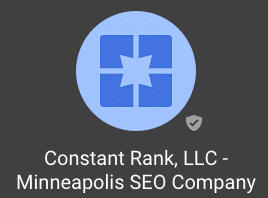
Not sure how these guys are getting away with this still…. but adding descriptors like this “Minneapolis SEO Company” to a business name is no longer allowed
What to Do: If you believe your business name was inputted in correctly, you can change it on your business dashboard. Obviously, if you do change it Google will probably require another re-verification phone call or post card.
End Goal: Verify the Business Name on your Google My Business dashboard is acceptable and correct (not using spammy keywords
5. Use the Correct Address
What to Do: Make sure your address on your page is 100% accurate. You should check with USPS to verify its accuracy – You can do so on their website. Don’t add stupid stuff like more accurate directions, cross streets, and descriptions that have no business being in the address field.
P.O. boxes are not allowed per Google’s address guidelines, so make sure it’s a local address. Another important point to mention: if you need to put a mailbox or suite number in your address, make sure you list your physical address on Line 1 and put the mailbox or suite number on Line 2. I’ve heard many horror stories about people doing this incorrectly and having an effect on rankings.
End Goal: Make sure your business address on your Google My Business page is 100% accurate and how it is to be listed across the web.
6. Use the Correct Phone Number
The listed phone number on your Google My Business page should be the local phone number associated to your office location. Please oh please don’t use an 800 number. Make sure your local phone number includes the area code and is the direct number that will reach your business.

What to Do: Make your phone number in your my business dashboard is the local number for your office.
End Goal: Make sure your local phone number is 100% accurate on your Google My Business listing
7. Use the Correct Website URL
What to Do: Make sure your website url is listed as the homepage of your actual business website. This goes especially true for single location businesses.
If you have multiple business locations, target each My Business page to the designated landing page for that location. However, make sure that landing page is not off of the target url on a different domain altogether or a social media profile. In that case just stick with the homepage of the company.
In all reality though it’s all about the user, if the person is clicking on your URL from your Google+ page wanting to go to your website, put yourself in their shoes and ask yourself which page you’d want to land on. More than likely it’s going to be the page with that location’s information on it.
End Goal: Make sure your Website URL or Landing Page URL is listed on your page, specifically the url the correlates best with the business location.
8. List the Correct Categories for your Business
This step may be the most crucial of the entire Google My Business section. Listing your business under the wrong category can be detrimental to a business’ online visibility.
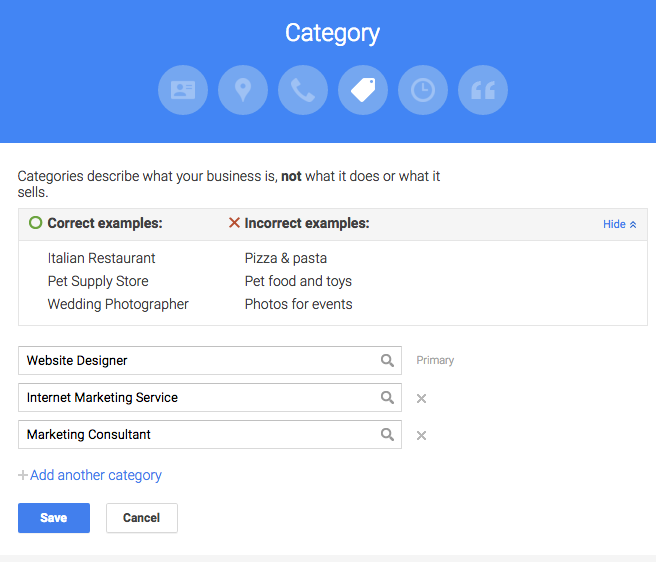
What to Do: You should honestly be listing your business under every category that accurately “describes what your business is” per Google. No, this doesn’t mean being spammy, but find the categories that are relevant and USE them.
The primary category should be the one that “most accurately portrays your business”.
These are some of my favorite tools for finding categories to use:
Blumenthal’s Business Category Tool
Finding a primary category is key and should not be overlooked. Every other category should be an add on to the primary. In example, we use 4 different categories for our business and they all apply in one way or another.
End Goal: Find the most appropriate and relevant categories to list your business page under
9. List the Correct Hours of Operation
What to Do: List your correct business hours on this page. Remember that if you have seasonal hours you’re going to have to remind yourself to come back in and change them when needed. Remember that updates to your hours can take 24 hours.

End Goal: List the appropriate business hours
10. Create an Introduction for your Business
This is the time to really get down and describe what your business is really about. Google wants you to add a brief description of your business and what you do. Make sure your description is unique and follows the guidelines.
What to Do: Write a 150-300 word description about your business. Make it readable and make sure you’re not just spamming keywords.
Another tip for great CTR: Use Hyperlinks to link over to different parts of your website if you offer multiple services. Yes, the links are no follow but they do provide for an easy way for visitors to get to the page they want from your description.

End Goal: Write a 150-300 word unique description about your business with proper links to corresponding pages.
11. Make Sure Your Profile is at 100% Complete
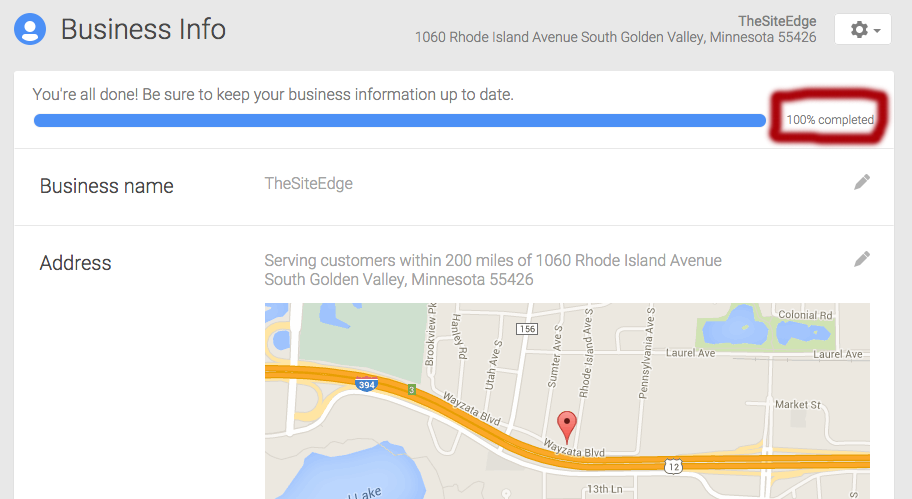
End Goal: As simple as it gets but make sure your Google My Business profile is at 100% complete. If it’s not…well geez..just get it done already!
12. Identity Photos are Uploaded Correctly
The business photos section of your Google My Business is separated out into a few sections, the first being your identity photos. There are 3 photos you need to upload that are crucial to how your listing appears in search results: A Profile Photo, A Logo Photo, and a Cover Photo.

What to Do: Upload the proper identity photos. These photos are crucial for Click Through Rates because if a user sees a photo next to a business in map results that makes no sense whatsoever, it could deter them from even clicking on it. I would recommend uploading a high quality logo file. We used a logo file for our profile as well, but this may be something else if you own a restaurant or other brick and mortar business. Perhaps a picture of customers eating, etc.?
The cover photo should accurately describe your business and be large enough to support a full screen view mode. (In other wards, don’t use a tiny photo)
I would definitely do a check to see what’s coming up in your search results for your business to arrange photos correctly. (type in your business name on google maps) Sometimes Google chooses to display a photo for what they think is best and if you think it’s not the right one to use, you might as well delete it so they can select another.
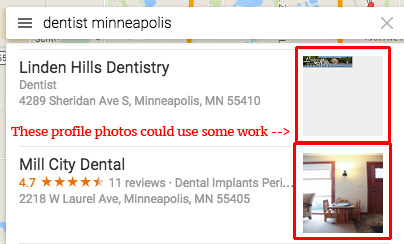
End Goal: Upload the identity photos for your business that most closely associate with your business activity.
13. Use a Trusted Photographer for a Virtual Tour (optional, but recommended)
If there’s one thing you can do from my opinion that will get you on Google’s good side, using one of their recommended trusted photographers to shoot a virtual tour of the inside/outside of your business is the way to go. When completed it will be added to your Google My Business page so visitors can take a look.
As much as its not mentioned that it helps your rankings in any way, I find it hard to believe that there wouldn’t be advantages if Google is hyping it. Unfortunately it is not free, but if you have the budget to do it, don’t shy away.
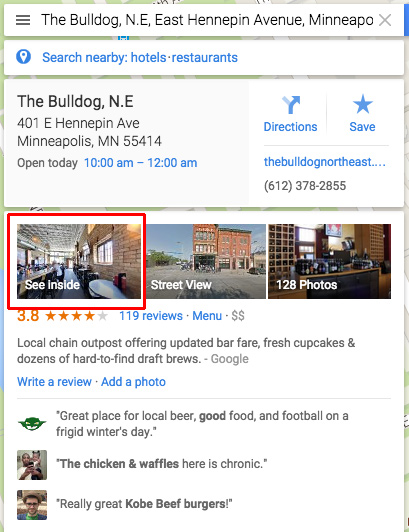
Visitors can click “See Inside” for a virtual tour. Pretty awesome!
What to Do: Head to your Google My Business page and click the “Add Virtual Tour” link. This will guide you through the process of scheduling a Google Trusted Photographer to come out and complete the shoot
End Goal: If you have the budget, schedule a Google Trusted Photographer to shoot a virtual tour of your business for your page
Resources Mentioned in Chapter 1
Google My Business Dashboard Homepage
Guidelines for representing your business on Google — By Google Support
Google Places Finder Tool — By Michael Cottam
Google Business Category Tool — By Mike Blumenthal
Chapter 2: On-Page Optimization of Website/Landing Page
On-page optimization for the business’s website or landing page is a key factor in the Local SEO. If you’re in the middle of a website redesign, I’d consider this as priority WHILE you’re completing pages for the website as there’s never a better time.
Unfortunately, for us as an agency, most of the time we get the website handed to us at a later date. It’s then time to go back in and optimize properly for Local SEO. It may be the same to you as a business owner if you’re just discovering Local SEO.
Per Moz’s Local Search Ranking factors report, On-page signals were ranked as the top factor in Local SEO rankings. So this section is ULTRA IMPORTANT.

Important Point Before Starting: Make sure your homepage/landing page is indexed already in Google before continuing. You can do this by typing in the URL for your landing page in Google search to see if it pops up – make sure it is or you may be looking at penalties that will require further attention.
Let’s get right into it.
1. Google Webmaster Tools & Google Analytics
I like to start with this step, as I honestly feel having authorization to Google Analytics/Webmaster tools up front can help a lot in the long run. There’s useful information littered all over these two, especially webmaster tools.
Webmaster tools allows you to see that your website is indexed properly, that there are no penalties, and to see if there are crawl errors. They also have a newly updated keyword search tool as well to take a gander at keyword searches that you can’t see in Google Analytics.
Bing Webmaster tools is also helpful to sign up for but I see Google as the priority right away.
How to: Head to analytics first to make sure you have authorization and have it set up. Then go over to Google Webmaster tools, login with account info and click add a site, remember you’ll want to add the non-www and www version of your site, along with https version if you have it, and then select your preferred site once inside webmaster tools. It’s easiest to verify the sites through Google Analytics.
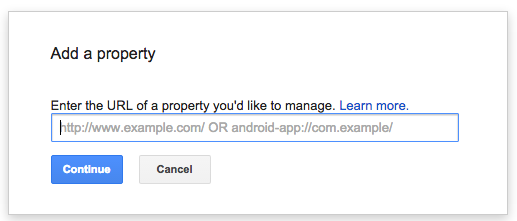
End Goal: Make sure you have full access to your own or client’s Google Webmaster Tools and Analytics. Ensure the targeted homepage/landing page is indexed in Google
2. Determine Site Structure ahead of time
The structure of your site needs to planned out ahead of time before anything else moves forward. What is your goal with Local SEO and what will you be targeting? Some big factors to determine before moving forward:
- Does the business have 1 location or multiple locations?
- Are there pages for each separate service that the business offers?
- Are multiple cities being targeted for the same keywords even if the business has no physical presence there?
How to: If the business has one location, the homepage should be the hub of information. From there you should see a structure of sub pages for each service offered.
If a business has multiple locations, make sure you are optimizing location landing pages and URLs. Although many have stated that having multiple locations on the same page is okay since Google has become smart enough to understand, the optimal format would be to have a locations page that links to the specific locations of each office. Each office location would have a /cityname URL for ideal structuring.
Covering Multiple Cities for One Location: Let’s say your business has one location (We’ll use Minneapolis for example) and you want to rank not only for Minneapolis Plumbing, but also St. Paul plumbing since the city is right next door. Keep this in mind and make sure you mark down how you want the site structure to lay out ahead of time.
End Goal: Draw up a diagram (with your client if an agency) on how you want to structure your website for the Local SEO campaign moving forward (whether it be adding new pages, or redesigning existing structure)
3. Correct NAP on Website or Landing Page
As with anything Local SEO, having the correct Name, Address, and Phone Number on your website and landing page will always be the #1 key to success. Because if you screw up there, it pretty much negates everything else.
How to: Make sure your Business Name is correct with no additional keywords added to it. Make sure the address is listed properly and the phone number is a LOCAL phone number, not some 800 number or tracking number implementation.
Everything on your website/landing page should match your Google My Business profile and make sure that it is written as text on your website, not an image.
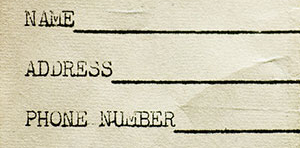
End Goal: Have NAP in text form on your website (either in footer or in main content will work) We will take this one step further in Chapter 4 by optimizing the NAP with schema markup.
4. Optimize Title Tag/Meta Description
Before getting into this section and going further, I recommend getting the MozBar toolbar for your browser. It makes viewing the current titles/metas/headers very easy along with showing important domain/page metrics.
This is probably one of the most important parts for Local SEO on page optimization. Making sure your title tag contains City, State and your Keyword is key. Don’t make it look spammy but arrange it in a way that looks professional and brings those 3 things front and center.
Here’s some great examples that Phil Rozek at Local Visibility System lists on his blog: 50 examples of title tags that rock.
Same goes for the meta description which is the bit of information generated underneath the title in Google search results. Your description should be catchy but still include city, state and keyword. Many people recommend throwing your phone number in the meta description as well, although remember that this won’t be able to be tracked by analytics if people call you directly.

How to: Change the title/meta description in your content management system, whether it be WordPress or anything else. I highly recommend the Yoast SEO plugin for wordpress – makes changes very easy.
End Goal: Change your website homepage or landing page title tag and meta description to make sure it contains your city, state and keyword that is being targeted in an effective yet not spammy way. Include the business phone number if appropriate in the description as well.
5. Header Tags are Completed
Make sure your header tags add value to your on page optimization. This includes not only the H1, but H2, H3 and whatever else you choose to use. Make sure there is a hierarchy when it comes to information you’re listing out.
The most important header tag, your H1, should include your city, state, and keyword again as long as it looks non spammy. Remember, you should stick to only one H1. Many carousels and slideshows out there include multiple H1s. This hurts your chances of ranking for one keyword term as it spreads your keywords too thin amongst the one page.
![]()
How to: Head into your CMS and change your H1 header to make sure it includes city, state and keyword. Adding keyword or city state to an H2 or two across the page can’t hurt either.
End Goal: Ensure your Header tags, especially the H1 tag, reinforce the local optimization of your city, state and keyword
6. Write Incredible Unique Landing Page Content
Relevant, unique, and insightful content about your business is a game changer for Local SEO. The content should accurately describe and revolve around the keyword that you’re optimizing for but also drive the visitor to take action!
However, don’t be spammy. Write unique information that helps customers understand the service you do. The key is Know What Your Audience is Looking for when they come to your page. Write a bit about it, maybe 300-500 words spaced out into sub headers and drive them to do something, whether it be call or submit a form.
Here’s some great resources about what to write on local landing pages:
- Landing Page Writing Tips – By Hubspot
- Rank with Well Written Landing Pages – By Expresswriters.com
- Simple but Powerful Landing Page Copywriting Tips – by Unbounce
I usually try to include something about the local area (landmarks, etc.), include a review from a local customer, and explain a bit about the service you offer and why you’re different.
How to: Write some content about what your local landing page is about, make sure to keep it locally focused and make sure it is unique. Hire a writer if need be but ensure it aligns with the service or business you are promoting
End Goal: I recommend between 300-500 unique words of content that answers your visitors questions that come to the page.
7. Include your Business Hours
Make sure your business hours are in a prominent location your landing page. Many people are interested to know when you’re opened.
Google released a study saying that 54% of smartphone users who do a local search are looking for Business Hours.
How to: Ensure your business hours are listed in text form so Google can crawl the page in a prominent location. I would also recommend using schema markup – but I will go over this in Chapter 4 below.
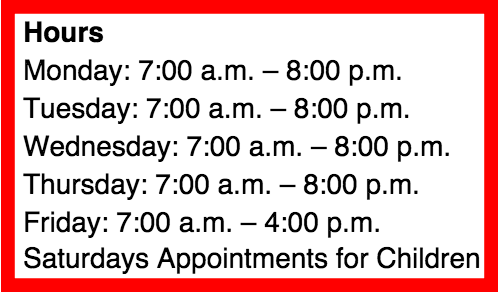
End Goal: Display the proper business hours on your landing page
8. Include Customer Reviews/Testimonials
Nothing conveys trust more than customer reviews, and including a few text reviews that people have sent you on your landing page is definitely the way to go. Make sure these are real reviews from real people.
A tip: Include some proof that the reviewer is a real person (social profile with their permission) and also make sure the reviews don’t sound fake. (See this article on Unbounce about Why people don’t trust testimonials) Use reviews submitted that include numbers and percentages that peak user interest.
I would also include links to your Review Profiles on well known sites like Yelp, Google+, Angie’s List, Facebook, etc.

How to: Include 1-2 written customer reviews on your landing page. We will optimize these with Schema Markup in Chapter 4 for increased visibility. Also include text or image links to your 3rd Party Review site profiles.
End Goal: Include customer reviews to increase consumer confidence and review site links
9. Image Optimization for Size & Search
Optimizing the images on your pages for both speed and search engines is crucial. I add this in because it can have a huge effect on the way your website is perceived on both ends.
If your images have no alt text tags, search engines will not be able to crawl them and therefore know what they’re about. Also make sure to not have important text saved as an image. It needs to be html text.
As far as image sizing goes, your image size needs to be less than 1 mb each as a general rule. If your images are larger than that, they have not been compressed for the web, which can slow down your web loading time immensely.
How to: Head into your CMS or editor and edit the alt tag for uploaded images. You’ll want to include the city state and keyword/business in your alt tags so Google can crawl them.
In order to compress images for the web so there is no severe loss of resolution, there’s several easy ways to do this. Whether it be using a plugin like Smush.it or Kraken.io, an image optimizing website or just doing it in Photoshop yourself, here’s a few resources:
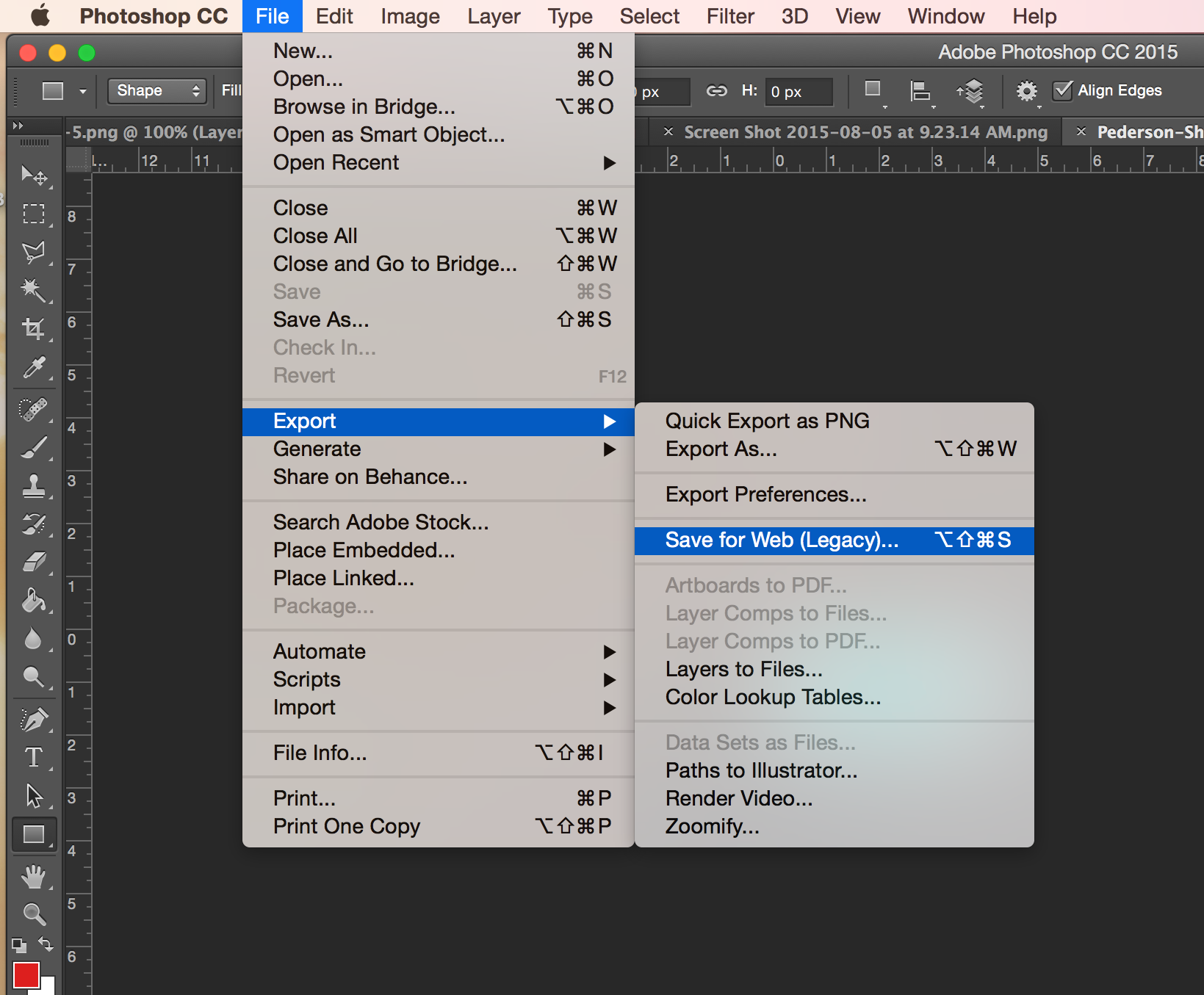
End Goal: Compress all of your images for the web. Fill out alt text tags for all images.
10. Mobile Friendliness
Since Mobilegeddon back in April, Google has focused on mobile friendly search results. If your website is not optimized for smaller screen sizes it’s time to figure that out because it will only become more important moving forward into the future. And as I stated earlier according to Google, 54% of local searches came from a smartphone. You want to make it easy for potential customers.
Responsive designs are the way to go as we do this for our clients’ websites. This way your website will resize itself to coordinate with the screen size it’s being viewed on. Plus it eliminates the need for a separate mobile site. Google has stated its preference for responsive websites as well.
How to: You may need to redesign your website to make it mobile friendly, or at worst complete a separate mobile site. (although if doing a separate mobile site, watch out for duplicate content) Contact your web designer for advice. There are tools out there to make your site mobile friendly on a budget if really needed as well.
End Goal: Make sure your website, or at least the designated landing page is mobile friendly.
11. Site Speed is Extremely Important
Google has proclaimed that site loading speed is a factor in their algorithm. Even more so, if your site or landing page loading time is slow, you will deter customers from sticking around and they will leave. Don’t optimize everything and expect to get leads if your site loading time is horrid.
How to: You’ll want to test your site first. I would go through and test the homepage and any relevant landing pages separately. Use GTMetrix.com to run a site speed test on the URL of your choice. Ideally you’ll want a page load time under 3 seconds, but honestly the faster the better. If you’re struggling with this, consider optimizing images and any other recommendations that GT Metrix does list off.
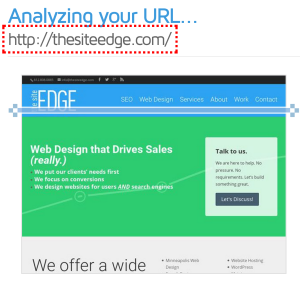
GTMetrix is free and analyzes your site speed quickly, giving you a generic idea where you stand
Otherwise, if this is your business and your life depends on it, why are you paying for crappy hosting? Get quality hosting that will keep your site running around the clock and FAST.
A few review resources for hosting companies I recommend: (all unbiased, non-affiliate reviews)
- Ultimate Guide to the Best WordPress Hosting
- HostingReviews.io – Hosting Comparisons
- Host Bench Marker – Real Web Hosting Stats
End Goal: Make sure your landing page(s) speed is optimal for the users that visit it – try to keep it under 3 second load time on GTMetrix
Resources Mentioned in Chapter 2
Google Webmaster Tools – Go to Homepage
2014 Local Search Ranking Factors – by Moz.com
Moz SEO Toolbar Download – download Mozilla/Chrome extension
50 Examples of Title Tags that Rock – by Phil Rozek
WordPress SEO Plugin – by Yoast.com
8 Must-Have tips for Writing Landing Page Copy – By Hubspot
Optimize & Rank with Well-Written Landing Pages – By Julia McCoy
8 Simple But Powerful Landing Page Copywriting Tips – By Ian Lurie
Why People Don’t Trust Landing Page Testimonials – By Pratik Dholakiya
18 Image Compressors to Speed Up Your Website – By Grace Smith
Properly Optimize Images for Web in Photoshop – By Jun Lumakang
Make Your Website Mobile-Friendly on a Budget – By Susan Gunelius
GTMetrix.com – Test your Site Speed
WordPress Hosting: The Complete Guide – by Sam Anthony
Chapter 3: Schema Markup for Local SEO
Launched in 2011, Schema.org was a step in the right direction for search engines like Google, Bing, and Yahoo. It allowed them to collaborate together to create a way for search engines to understand important information on websites.
Using “Schema Markup” for Local SEO is a way to stand out from the pack. It tells the search engines to display information in search results such as what type of business your website is about, reviews, hours of operation, events, restaurant menus, movie showing times and so much more.
Let’s get started.
Local Business Markup
As we discussed in the chapter above, it’s important to have the Name, Address, and Phone number correct for a business on the website so the search engines can properly understand it. Marking up the location and contact information with Schema is taking it one step further.
When you use schema markup, the code behind it is not shown or known to visitors, only to search engines. You will display this location and contact information within div tags.
Let’s say you want to markup contact info for a local dental office called “Squeaky Clean Dental”. Here is what the schema markup would look like:
<div itemscope itemtype=”http://schema.org/Dentist”>
<span itemprop=”name”>Squeaky Clean Dental</span>
<div itemprop=”address” itemscope itemtype=”http://schema.org/PostalAddress”>
<span itemprop=”streetAddress”>16 Smith Street</span>
<span itemprop=”addressLocality”>Chicago</span>,
<span itemprop=”addressRegion”>IL</span>
<span itemprop=”postalCode”>60290</span>
</div>
Phone: <span itemprop=”telephone”>555-423-2352</span>
<a href=”http://googlemapsurl.com” itemprop=”maps”>Get Directions</a>
</div>
But on the front end it would just look like this:
When it comes to business types such as http://schema.org/Dentist, there are a ton of different options depending on the type of business you’re doing this for. Many people just put “schema.org/LocalBusiness” as the business type which is fine, but if there is a more exact match category, definitely use it. It can only help.
You can find the broad list of categories that are available here on schema.org. (or see the picture below) Scroll down to find the broad list of categories. The broad categories open into more specific niches as well.
In example, if your business is a “LocalBusiness”, instead of using the next category called “AutomotiveBusiness”, you can move into the type of store such as “AutoBodyShop”. LocalBusiness > AutomotiveBusiness > AutoBodyShop <- Use the most specific category.
Logo URL & Same As Property
Some other properties that can help can be identifying the logo and using the “same as” property to associate your page with the proper Google+ Account which helps Google easily know they’re related) Also using coordinates to tag your location by Latitude and Longitude just adds one more beneficial factor.
<img itemprop=”logo” src=”http://www.squeakycleandental.com/images/logo.png” />
<link itemprop=”sameAs” href=”https://plus.google.com/+SqueakyCleanDental”>
Geo Coordinates
Using coordinates to tag your location by Latitude and Longitude just adds one more beneficial location factor.
<span itemprop=”geo” itemscope itemtype=”http://schema.org/GeoCoordinates”>
<meta itemprop=”latitude” content=”43.9282194″ />
<meta itemprop=”longitude” content=”-93.3570221″ />
</span>
Review Markup
I’m including a section on this now mainly because I no longer see review markup as a good option. Schema Review markup allows you to mark up testimonials on your website so that Google knows they are reviews. And because of this Google would display the review “gold stars” underneath search results for those particular companies/products.
Here’s an example:
Here’s the code on the backend:
The problem with the above is that clearly the author of the website put information in that they had “160” reviews and they have a “4.7” rating based on no factual evidence. This has turned into abuse by many websites as one could easily fake reviews and recently people that have been doing this have been given manual penalties by Google for spammy markup abuse.
I believe everything will be shifted over to Google+ reviews eventually, at least for business reviews. (product reviews are another topic for another day). Stick to your Google review strategies that we’ll discuss in chapter 5.
However if you’re interested in learning more about review markup and to try it for yourself, I’d suggest reading this article about Review Markup by Carrie Hill. (Remember, Google doesn’t have to display your stars in the rich snippet, and it seems like everyday they’re showing less and less of them)
Event Markup
Not enough businesses do this, and it can be awesome way to take advantage of showing up in local search results for upcoming events. Not only that, but you get some added space in the search results as well which presents a greater chance for higher click through rates to your website.
Whether it be classes or workshops the business is hosting, festivals, concerts, sports events, and much more, it can all be marked up with Schema to display in the SERPs like this:
If you have events on the calendar make sure you go to schema.org/Event so you know which type of event to classify it as first:
Here’s an example for a made up Craft Beer Festival:
<div itemscope itemtype=”http://schema.org/Festival”>
<a itemprop=”url” href=”www.craftbrewfestivalexample.com”><span itemprop=”name”>Craft Beer Festival<span></a>
<div itemprop=”description”>100 of the Best Craft Brews to try</div>
<meta itemprop=”startDate” content=”2015-07-18T14:00″> Starts: Friday, 07/18/15 at 2:00 p.m.
<meta itemprop=”endDate” content=”2015-07-20T20:00″><br>Ends: Sunday, 07/20/15 8:00 p.m.
<div itemprop=”location” itemscope itemtype=”http://schema.org/Place”>
<a itemprop=”url” href=”www.mnstatefair.com”>State Fair Grounds</a>
<div itemprop=”address” itemscope itemtype=”http://schema.org/PostalAddress”><span itemprop=”addressLocality”>Minneapolis</span>, <span itemprop=”addressRegion”>MN</span></div></div>
<div itemprop=”offers” itemscope itemtype=”http://schema.org/AggregateOffer”><span itemprop=”lowPrice”>45</span> – <span itemprop=”highPrice”>65</span>
</div>
</div>
As you can see Schema Markup for Events can work for any type of event and can help your chances of showing up in local search results for specific events and under your company name.
It’s just one more thing you can do to stomp on your competitors!
Resources Mentioned in Chapter 3
Schema.org – Official Schema Website
Local Business Categories – Schema.org
Schema Markup for Reviews – by Carrie Hill
Event Markup – Schema.org
Chapter 4: Building Citations with Authority
Ahh citation building. The epitome of local SEO. Citation building always seems to be a heated debate amongst Local SEOers. Is it really necessary? How many citations are needed for a quality citation profile? When is the right time to build citations? We typically shoot to start building citations for a business after the Google My Business profile is set up and after the website/landing page has been optimized for on-page. At that point the business should already be seeing results and the citation building should only add to its success. Plus citation building takes time, lots of time, especially if you’re building them manually, which I definitely recommend.
In this section I’ll go over some must answer questions, along with walk you through the top 25 citations and how to build your profiles for each. Remember Google runs on a trust factor and user experience. The cleaner and more authoritative citation profile you have, the more likely Google will see you as a trusted business that they’ll display higher in the SERPS.
Why build citations manually?
There is nothing better than having full control over your citations. That’s why building your citations manually and keeping track of them in a spreadsheet for potential future changes is especially important. I’ve included a link to our spreadsheet that we use to build manual citations:
Our Citation Tracking Spreadsheet Feel free to download, use, or share it.
Services like Yext submit citations but require a yearly fee, and if that fee isn’t paid, your listings are basically reverted back to what they were before submission depending on the publisher’s policies. Manual citation building vs an automatic submission service? I choose manual every time:
- No Yearly Ongoing Fees
- Have complete control over each verified citation listing
- Won’t lose listings after fees aren’t paid
- You get to personalize the listings (VERY IMPORTANT as each citation is different)
That being said, I will recommend certain paid services, such as Moz Local for specific tasks, mainly because of the cost being just $84 annually and they will get your business listed in the main 4 data aggregators: Infogroup, Localeze, Acxiom, and Factual. It would usually cost you the same to get listed in a few of these directly anyways and this way you’re guaranteed an in with no work. We’ll talk about these a little later in this section.
Begin with the Citation Audit
Conduct an audit of the business’ citation profile before doing any new citation building. Not only is this a good idea for long standing businesses that may have a lot of previous citation issues, but also for newly created businesses. Even though no citations have been built manually, it’s likely the new business information has been passed around by aggregators on the internet already. You’ll want to make sure that its clean and the NAP wasn’t incorrectly submitted in any way.
Tools I use to conduct the initial citation analysis:
Brightlocal – one of the best Local SEO tools out there from my point of view – has a great citation analysis tool to compare and steal citations from your competitors (you can get a 30 day trial and prices are reasonable afterwards as well, this is great for agencies)
Moz Local – Great free tool for checking the top guys (google/bing/axciom/etc.)
WhiteSpark – Checks the 50 top citations for your business – will find relevant citations for your industry. A paid service I would also recommend for major data aggregators.
Yext – Yes, you can use Yext to run a quick citation analysis without buying the service After using these tools, you should be able to get a pretty sound idea on what work lies ahead of you.
Top Things to Check for in the Citation Audit
- Incorrect NAP info in listings
- Closed locations that still exist at same address
- Duplicate listings
Tip: Use BrightLocal to Top Your Competitors
I use this step because it’s necessary. Know which citations your competitors have and don’t have, and then you can take make a move to get the citations that matter for your own business. Finding which citations the top ranking competitors have in your business niche is easy just by running a report in Bright Local. Make note of which citations you need to add to match and beat your competitors and add them to your spreadsheet. Save them for later as those will be ones you’ll want to cover after running through my Top 25 list.
It’s Time to Start Building
Now that the audit is completed, you should have an idea of the direction you need to head. There are 3 main types of citations that you should be gunning for as you move forward:
1. Top National Directories (I will go through my recommendations in just a moment step by step; this includes Facebook, Youtube, BBB, etc.)
2. Top Industry Relevant Directories: These will depend on your business niche and you’ll usually be able to find them easily by searching your keywords and cities to see which directories pop up in the top SERPS (e.g. wellness.com for health niche, findlaw.com for lawyers, etc.)
3. Local Relevant Directories: This could include your local city’s business directory, chamber of commerce, etc.
The Killer 15: The Top Citations that give an Edge
We’ve created this Killer 15 citation list to help you get a leg up in your citation building for Local SEO campaigns. These are all high authority and important citations that we have seen kill it for our clients, hence the name. Should you stop after these? No, but creating these citations and personalizing them can go a long ways.
Note: These are high quality citations that also tend to be the high traffic sites. Many Local SEOs as well as myself use a different email address to register citations to avoid spam emails later on, but these citations you will want to have a branded email to help with the verification process. Trust me things will go 100x smoother. Advise your client of the same when doing this. (ex. info@yourdomain.com)
In this section, I’ll discuss the following about each of these top citations:
- Citation Name/Domain Authority (DA)
- Follow or No Follow Link to Website (Yes, there are some follow options)
- Verification Process
- How To & Profile Tips for Personalization
- Timeframe to Live Listing
1. Bing Places
DA: 97
No Follow

Obviously Bing would be second to Google being a powerful search engine. Registering and personalizing a business citation with Bing is crucial.
Verification Process: By Phone or Postcard (Up to 1-2 weeks)
How to: Bing is similar to Google in the verification process. Head over to bingplaces.com. If you don’t have a Microsoft account, you’ll have to create one. Once logged in, search for your business by name or phone. If it doesn’t pop up, you’ll have to create a new business and go through the steps. If it does pop up, claim it and then go through the verification process.
Fill out the profile info to the fullest, this includes NAP, hours, Social Media Profiles, URL, etc. Bing is one of the high traffic websites, so give it a personal touch. Make sure to add photos.
Timeframe: Upon successful verification, listing usually takes up to 72 hours to go live.
2. Yelp
DA: 94
No Follow

Yelp is high authority and very necessary for many service based businesses, especially restaurants. A high quality source for customers to review and analyze businesses, having a completed profile is a must.
Verification Process: By Phone – Must type in code to Verify
How to: Pop over to Yelp for Business owners, biz.yelp.com/ and search for your business. If it pops up, click to claim it and follow the step by step process. If you need to create a new profile, scroll to the bottom and go to “Add business to Yelp”. Add your info and complete the process.
I would say that photos are going to be the most important info on a yelp page, along with hours and menu if you’re a restaurant.
Timeframe: Same day verification by phone – live within 72 hours typically
3. Facebook
DA 100
No Follow
![]()
Facebook isn’t just social network, it’s a high authority citation that needs to have your business NAP info displayed on it.
Verification Process: A couple minutes – there is no current verification process for Facebook, but you should select the option that says that you are a real business venue or establishment
How to: Head over to the Create a Page Option on facebook. Select Local Business or Place or Company, Organization or Institution. Follow the steps. Fill out the profile completely. Remember it is important you put the entire address, phone and website URL in so it will be visible once the page is created on the left hand side of the wall.
Categories again will be key on Facebook, so make sure you’re selecting relevant ones. And please make sure your businesses images look professional. Use the right sizes so they’re not blurry and pixelated.
Here’s an excellent link for a downloadable template to use to frame your Business cover photo: Facebook Cover Photo Template
Timeframe: Live upon creating page
4. YouTube
DA: 100
No Follow

YouTube is a highly effective kill tactic in Local SEO. Not only is it a top citation source, but many people don’t know that you can include your NAP and website info in the description. And they’re owned by Google. Win Win.
Verification: None, but try to attach your Youtube account to your Google+/My Business Account
How to: Well first things first, you’ll have to create a video. Don’t have a video camera? Create a quick slideshow, honestly anything you can get into a video viewing format and post on the site. When editing the description of your video make sure you include following info in the description field:
- Full Name, Address, and Phone of Business
- Website URL (include http:// in URL as Youtube will automatically turn it into a link after saving)
- Biography about your company – including some non spammy local keyword throw ins as well (can’t hurt)
Make sure to geotag your location in the advanced section as well – This can be super clutch.
Timeframe: Live upon video upload and processing.
5. Yellow Pages (YP)
DA: 89
No Follow

The original Yellow Pages still has some value as a top citation to get listed under (for free that is). Would not recommend using their advertising services, but that’s for another day.
Verification: Verify by phone – you’ll have to punch in a code
How to: Head over to yellowpages.com and you can go to “Get Your Free Listing” to start the process. Search for your business to see if it exists already, if anyone would have it, it’s probably Yellow Pages. Otherwise add a new process. Since yellow pages is a high traffic site, you’ll want to customize your listing with as much info as is allowed.
Phone verification will complete it and you’re on your way to a YP citation.
Timeframe: After phone verification, live in up to 72 hours.
6. The 4 Data Aggregators: Infogroup (Express Update), Acxiom, LocalEze, & Factual

Doing a majority of these citations manually is great for personalization reasons and to get listed fast, but the 4 main data aggregators are what hold the true value. Starting early on getting listed with these guys will usually filter your citations down to smaller directory citation sites, even including some on this list.
The problem is, these guys are a PAIN to get listed with manually and some of theme like LocalEze only allow paid listings. This is the only point where I’ll highly recommend you shell out $84 to Moz Local. They’ll submit your information to each of these for you and save you hours of time and outreach.
Time Frame: If using Moz Local, it can take between 4-8 weeks for live listings on all of the aggregators
7. Yahoo!
DA: 100
No Follow

Yahoo is a worst nightmare for manual built citations. They seem to have moved to the mentality that they’ll just wait on approving your listing until you pay for their “Yahoo LocalWorks” which is basically Yext. In fact their feedback forum for Yahoo Local is literally just people going on rants about how no one approves their listing. You can see it here for a good laugh.
Nonetheless, it’s still a very powerful citation that you should attempt to get verified. It is likely if you don’t get verified right away that if you submitted to the data aggregators above that your listing will get filtered into yahoo eventually.
Verification: By Phone after submitting listing or by Domain Email
How To: You’ll have to create a Yahoo ID to begin the process on this one. Head to Yahoo Small Business and search for your business, if found complete the claiming process, otherwise choose add a new business and go through the steps. The verification process is pretty easy, it’s just the approval that seems to take forever. Check on this one every couple months to make sure it’s been approved.
Timeframe: Yahoo is now saying 60+ day turnaround for approval. Ridiculous, I know, but do it anyways.
8. Linkedin
DA: 100
No Follow
![]()
Creating a page for your business on Linkedin is a must. It’s a powerful citation source and social media source and can link out to employees across the internet which can really help your visibility.
Verification: None, just clicking accept and submit posting
How To: Head to linked in and click on Add a Company. Add company name and company domain email to certify you’re an official rep for the company. Note** You need an email that is @yourdomain.com, Gmail addresses will not work. Then you’ll have the opportunity to fill out NAP & company info.
Linkedin Profiles are definitely something you’ll want to personalize. Use your logo prominently and create a custom cover photo. Here’s a great link to a downloadable cover photo template: Linkedin Cover Photo Template
Timeframe: Live almost immediately upon creation
9. Angie’s List
DA: 89
No Follow
![]()
Verification: By Email
Angie’s list is a site for paid subscribers, so you won’t have much access unless you’re a paid subscriber yourself. However, Angie’s list does let you get a free listing up for your business with minimal info on NAP and Business categories. And it’s very high authority citation once again.
How To: Search for your company to see if it exists in their database already. If not, add your business details and verify that you’re an active part of the company. Angie’s list again is a paid subscriber site with a dedicated user base. You won’t be able to add much info unless you pay for their premium listings.You shouldn’t need to though to just get the citation itself, although some service businesses have found great success with Angie’s list.
Timeframe: May be a few days for listing to be live after initial submittal
10. Manta
DA: 84
No Follow

Manta is all about listing small businesses. It’s a high power citation that is regularly one of the top 20 I’ll recommend.
Verification: You’ll receive an email after submitting your listing with a phone number & 4 digit code. You’ll have to call the phone number from your business line and punch in the code.
How to: Head over to Manta and click Add Business in the top. Ad your company info and submit. You should receive the email not too long after in order to verify your business by phone. Again not a lot of customization that can be done on Manta but just one of those citations you’ll need.
Timeframe: As long as it takes for you or your client to dial the number and punch in the code
11. BBB (Better Business Bureau)
DA: 95
No Follow or Follow
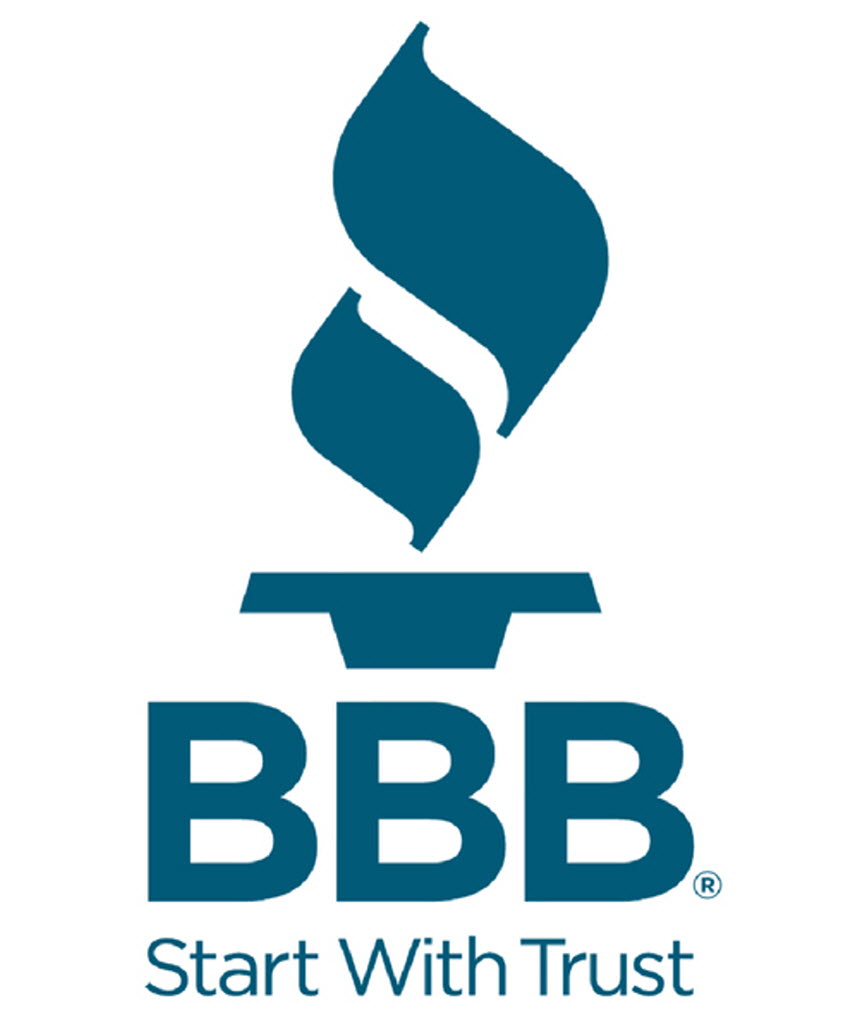
The BBB is one of the most trusted business organizations out there and therefore its citation value is very high. Whether or not you’re actually BBB Accredited, you can still add a free listing for a citation.
Getting BBB accredited and paying the dues might just be worth it if its in your budget since at that point your URL link will turn from a No Follow link to a very valuable Follow Link, and it may at that point be just enough to get ahead of your competitors.
There’s a great deal of heated debate about this since it’s essentially paying for a link, but Google seems to have no problem with it because of the BBB’s trustworthiness. You can read a great deal about it in this informative article on the BBB by Local SEO Expert Phil Rozek.
Verification: Option for Email/Phone/Post Card verification upon Approval
How to: I’m going to just recommend you read this detailed how-to by Mike Munter on How to Submit Your Business to the BBB. He goes into detail on how to submit for free listing and then getting accredited.
Your business does need to be at least 12 months old to be listed on the BBB.
Timeframe: A week or two for initial approval – longer for accreditation process
12. FourSquare
DA: 89
No Follow

Foursquare has recently been trying to rebrand itself after falling a bit in the business directory area. It’s still a top citation you’ll want to have for a business and their verification process is a bit of an oddity as well.
Verification: Pay $20 for instant verification and premium listing, otherwise have to wait for Post Card Verification by mail
How to: Head to foursquare and click on claim your business. If not found, click add business at the bottom, fill out and sign up. Opt for the post card option unless you really want to pay $20 and when it arrives at the business address, you’ll need the code to verify the listing. Be detailed in your foursquare listing and fill up the top pictures options with social media profiles. It’s how you can get the most out of this citation.
Timeframe: 1-2 weeks for post card verification
13. Merchant Circle
DA: 85
No Follow

Merchant Circle has always been amongst the top citations and continues to be. Get a free profile to get that NAP up.
Verification: By Email
How to: Create a free page and add your business info. Be detailed and then click submit. You’ll have to confirm your listing through the email link they send you, but just like that you’ll be up and running
Time frame: Live upon verification
14. Mapquest
DA: 94
No Follow

Mapquest is still relevant as a solid citation but they’ve made it quite difficult to add a basic free listing if your business is new by trying to make it look like they only support paid listings since they’ve partnered with Yext. The trick is just to know which page to go to.
Verification: After sending email with to support with correct info
How to: If your business is already listed on Mapquest, just search for it and when it comes up, click claim your listing and follow the proceedings. However, if you need to add a new business listing on mapquest you need to do a few steps.
You’ll need to Click here to submit a support ticket to MapQuest’s Team and include the following info:
- Business Name
- Address
- Phone Number
- Website URL
- Up to 6 Business Categories
- Latitute & Longitude location coordinates
After you’ve sent the request, you should receive an email back in the next couple days saying that the business has been added and it will be changed in their system over the next 1-2 days.
Timeframe: After addition, 1-2 days for listing to be live
15. Hotfrog
DA 66
No Follow

Hotfrog is still an old and relevant citation site. It’s easy to create a profile for free and you can include a ton of personalized information on it as well.
Verification: By Email
How To: Click on Add Your Business at the bottom center of the homepage. Fill out required info and submit. You should receive a verification email. Once you click the email link you’ll be taken to your profile. There’s actually a good amount of info they require for your profile to get to “100%” but make sure it gets there. Record your login info in the spreadsheet.
Timeframe: Live upon Verification
Continue Your Citation Building
The Killer 15 is a great start for your business but you’re going to have to do a little more if you want to win out in high competition niches.
BrightLocal has a great list of industry relevant citation sites: 1000+ Niche Citation Sites for 41 Business Categories
They also have an incredible list of top US city citations: Local Citation Sites for Top 100 USA Cities
Consider all of these as well as your competitor citation analysis in determining your actual plan for citation building.
Resources Mentioned in Chapter 4
Comparison Between Manual Citation Building and Yext – NGS Marketing
BrightLocal/Moz Local/WhiteSpark/Yext – Citation Analysis Tools
Facebook Cover Photo Template – Inlinevision.com
Linkedin Cover Photo Template – LinkedinCompanyPage.blogspot.com
BBB Accreditation: Boring But Bumps Your Local SEO – by Phil Rozek
How to Submit Your Business to the BBB – by Mike Munter
1000+ Niche Citation Sites for 41 Business Categories – By BrightLocal
Local Citation Sites for Top 100 USA Cities – By BrightLocal
Chapter 5: Customer Review Strategies
Online reviews have become the pillar of Local SEO in the last year. Not only in Google’s algorithms, but also in each and every customer’s eyes. You can be ranked as high as you want but if you have low quality reviews for your business, you’re not converting any searchers into customers.
If you had a choice looking at the below 7 Pack in the Google SERPs for the term “Dentists in Minneapolis”, which business would you click on?
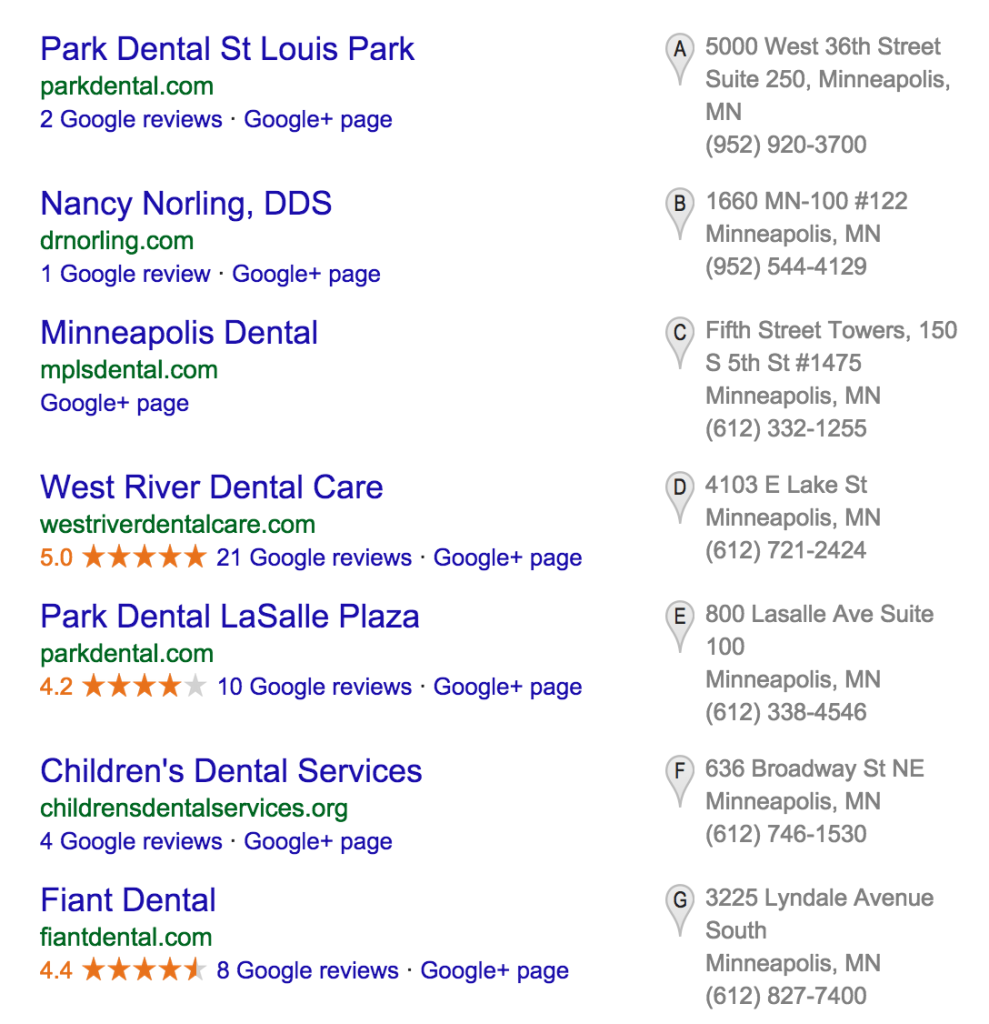
I’d have to say even though that that Park Dental pops up first, I’m definitely more inclined to click on the West River Dental Care with 21 five star reviews and those eye popping stars. That being said, even Park Dental LaSalle Plaza and Fiant Dental seem to catch my eye more than the top result.
What does this mean for businesses?
A #1 ranking won’t matter if you don’t have reviews. Our golden rule for Local SEO is this:
“The beginning target goal for a Local SEO campaign is to be ranked in the Organic Map Pack for your Local Keyword with a minimum of 5 Positive Reviews”
From there you can only move up!
**Google 3 Pack Update on August 7th – What does this mean for reviews?**
Google’s 7 pack above no longer exists, it is now a 3 pack looking like this:
What does this mean?
The reviews strategy WILL NOT change. If anything, reviews are more prominent than ever in the top 3.
Not only that, but if you click the “More Dentist” or whatever business category your search is in at the bottom of the 3 pack, Google will now take you to a Google Map view of businesses, which lists out 20 businesses and their reviews:
Reviews will matter more than ever when searchers reach this screen!
Places to Get Business Reviews for Local SEO
When it comes to reviews for Local SEO, I believe having a well rounded strategy is always a good idea. Allocating all of your reviews to one place is not necessarily the best thing, even if they are on places such as Google or Yelp.
That being said, if given a choice and having limited people that can review your business, I’d stick to a few of the main review sites depending on your business type (not necessarily in this order):
- Google+
- Yelp!
- Trip Advisor
- Industry Specific Review Sites
- Yellow Pages
- Yahoo! Local
- Angie’s List
- BBB
- Merchant Circle
- Judy’s Book
- Citysearch
There’s many to choose from, but for this particular section I’m going to focus on the top 5 because they seem to be the most heavily weighted in terms of helping local rankings both directly and indirectly.
Google+ Reviews
As you can see from my example above, more than anything else you should be focusing your Local SEO strategy around Google reviews. You could have 200 yelp and trip advisor reviews, but if you have no Google reviews, people won’t know you exist. Google’s algorithm revolves around them and Google’s searchers click on the results that include them.
The Gold Stars
The gold stars that show up in Google SERPS under the business name indicate the rating that business has achieved out of 5 stars. They are an aggregated count of all Google Reviews.
So why doesn’t my business show the Gold Stars underneath?
You need 5 Reviews or More in order for Google to show the gold stars in search results for your business.
Why does my business still show a 4.9 total rating even though I have all 5 star reviews?
Normally you will need 10 or more reviews for Google to display a 5.0 rating. Google seems to use an algorithm that believes it is likely you’ll obtain a review lower than 5 if you don’t yet have 10 or more reviews.
Why do Google Reviews Matter?
In the end, Google Reviews are one part of many of the Google Algorithm. According to the Moz survey on local search ranking factors, review signals equate to about 10% of ranking factors. However when you take into consideration the overall effect those shiny gold stars have on click through rate, I think it is much higher.
The Best Ways to get Google Reviews from Customers
Here’s a list of the top ways to get more Google reviews:
1. Customer Handout
Since you have to have a Google+ account in order to leave a review for a business, it’s important your customers know how to do the step by step process on leaving a review. Having a handout with simple instructions on hand to give to customers is an awesome idea that gets results for the non tech-savvy customers.
A great resource is the handout that Phil Rozek offers on Local Visibility System – Go there and get one, I highly recommend it!
2. Email with Link to Your Review Page
This is a highly effective strategy for customers you communicate already with by email or if you obtained their email. I would recommend sending them a personal email one at a time (not a mass email to everyone) and ask them if they would take a minute out of their day. However be careful in doing this because if too many customers leave reviews at one time Google may flag this as spammy.
Here’s an example of an email template (obviously you should personalize it as you see fit):
Hello <CustomerName>,
We appreciate your business and would love to get your feedback on how we did.
The greatest compliment you could offer us is to take a minute out of your day and leave us a review on our Google+ page. If you are willing, please click the link below to go directly to our review page:
(this is where you would put your link: use link text like Click to Leave Review or you could use an image
The URL that your link should go to is your Google+ URL with “&review=1″ added to the end of it.)
Thank you. We look forward to seeing you again soon!
Best Regards,
<ClientName>
3. Review Page on your Website
Having a place for a link to your Google+ Review Page on your Website is clutch. Use the review URL again which includes your Google+ URL with “&review=1″ added to the end of it. This will send them straight to your page to leave a review.
Yelp Reviews
Secondary to Google, I would rate Yelp as a go to for many individuals looking for more in depth reviews on a particular business, most notably restaurants.
Key points to focus on with Yelp Reviews:
1. Add a Yelp link to your website for people to review
2. Focus on Yelp Reviewers with a history – many yelp reviews are filtered because they are new profiles, only have one review, or are because the person reviewing hasn’t actually visited the business.
3. Do not try and buy or solicit reviews, it is against Yelp’s review policies, unlike Google where you are allowed to ask for Google reviews
Check out this full guide on Yelp Reviews over at Wordstream.com
TripAdvisor Reviews

TripAdvisor is monstrous. Don’t believe me? Check out this article on Business Insider on how TripAdvisor literally affects the entire tourist industry of entire countries because of its reviews.
That being said, if you’re running or working for a hotel, restaurant, anything travel related, make sure you’re on TripAdvisor and getting reviews from your customers.
Improve Your Ranking on TripAdvisor
The TripAdvisor Popularity index can have a huge effect on businesses that get searched for within a geographic region. TripAdvisor stated that the ranking is based on 3 things: Quality, Quantity, and Recency of reviews received. And if you try and game TripAdvisor and get caught, it can have a serious toll on your rankings.
Based on a recent study on Revinate.com, they found that almost 85% of the weighting of the Popularity index score is based on the Average Review Score, with only 6% on number of reviews and 9% for other factors.
What does this say?
As a business that wants to be ranked higher on TripAdvisor, this doesn’t rely as much on SEO and review solicitation, but more on providing a fantastic customer experience. Leverage those great customer experiences by asking for reviews at that point.
Facebook Reviews
Facebook is a top review site to me only just recently actually. The reason? Google now displays Facebook reviews as rich snippet Review Stars below the search listing.
EVERYONE is on Facebook and there’s a ton of businesses I see that have hundreds of reviews on Facebook with minimal amounts on other review websites, even Google. So the fact that Google is displaying these review stars in the SERPs now is huge for them.
So if you have no Facebook reviews currently, go out and get some!
Industry Specific Review Sites
Focusing on industry specific review sites is definitely right up there next to Google Reviews.
There are review sites specifically for Doctors, Lawyers, Dentists, Universities, Car Dealerships, etc. Find them and get yourself a profile and a few reviews where needed.
Again, Phil Rozek at LocalVisibilitySystem has a fantastic post on every industry specific local review site.
Resources Mentioned in Chapter 5
The 2014 Local Search Ranking Factors – Moz
How to Get More Google Reviews from Customers – By Phil Rozek
Complete Guide to Yelp Reviews – Wordstream.com
TripAdvisor Reviews Impact Tourist Industry of Entire Countries – Business Insider
How to Improve Your Ranking on TripAdvisor – Revinate.com
Industry-Specific Local Review Sites: The Definitive List – By Phil Rozek
Chapter 6: Link Analysis Essentials
I’m going to make the link analysis section brief and to the point.
The main idea behind a link analysis? So you know where you stand currently with your website or your client’s website. We’re taking a peak behind the curtains to understand the current value and authority of the website, along with making sure there are no potential problems looming in the future.
1. Get the MozBar, this browser toolbar will make this easy. Check your current website’s Domain Authority and Page Authority of the homepage/landing page. Write it down.
2. Browse the site’s link profile on Moz Open Site Explorer, Majestic, Ahrefs, or SEMrush to get an idea of what type of profile you’re looking at. I typically try and look at all of these since they each will pull in their own share of links that the other may not catch. Does there seem to be a variance of type of link? Does anything appear to be spammy looking? Are there any root domains that have large amounts of links pointing to the site? Take note of anything unusual looking.
Do you see a large number of links coming from overseas domains, gambling sites, pills site, payday loans, handbags, etc.? It’s likely the site may have a large number of spammy links targeted to it and is possibly even hacked. This is where you’ll have to start sleuthing even deeper before continuing on with your campaign.
If spammy links look to be an issue, I highly recommend this Link Audit Guide for Effective Link Removals & Risk Mitigation by Modestos Siotos.
Some other Google Penalty resources that can help you identify if the website has current issues:
Is My Website Penalized? – Online Tool
How to Identify if Your Site is Filtered or Penalized – Ahrefs.com
3. Verify there are no manual action penalties in Webmaster tools – ensure that you’re not going to have immediate problems to deal with right away. Log into webmaster tools and go to search traffic, manual actions to ensure there are no actions found.
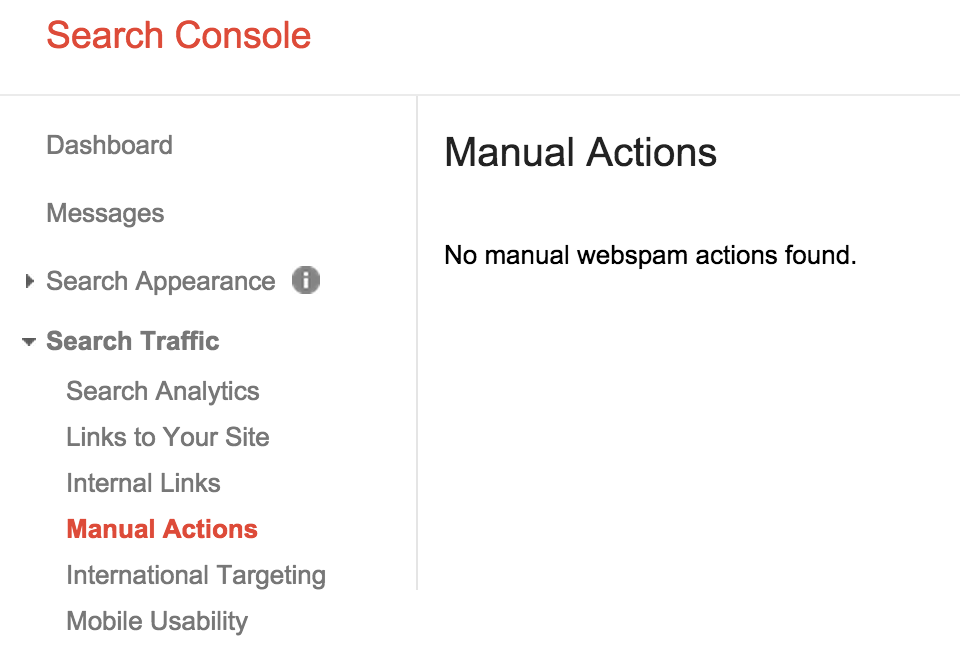
4. Review Google Analytics to ensure the site did not receive an algorithmic penalty. You’ll be able to get a good idea if there have been any recent algorithm penalties by just checking to see if there are any huge dips in traffic that don’t seem to make any sense.

I recommend reading this very helpful article by Robbie Richards on how to identify Google penalties and how to recover if you suspect this may be an issue moving forward.
After you’ve analyzed your site’s link profile and have a good understanding of the current situation it’s in, it’s time to move on to your competitor analysis.
Resources Mentioned in Chapter 6
MozBar Toolbar – Download for Chrome/Firefox
Link Audit Guide for Effective Link Removals & Risk Mitigation – by Modestos Siotos
How to identify and recover from Google’s manual & algorithmic Penalties – by Robbie Richards
Is Your Website Penalized? – Tool for checking website penalties
How to Identify If Your Site is Filtered or Penalized – Ahrefs
Chapter 7: Competitive Analysis & Winning Strategies
Completing a competitive analysis works for a million reasons. It shows you what strategies are working in your local niche and what you can do to improve on them in order to hopefully show your competitors up.
It will help you develop that finishing touch on the first draft of your Local SEO strategy.
That being said, this is just an overview. There’s always going to be many more unique options out there that can help distance yourself from competitors. Many of these will be in a more advanced category of Search Engine Optimization that will require hours upon hours of more work. (especially in more competitive local categories)
But to get started, a competitive analysis will show you the path you should be heading down.
Some things you’ll be able to gather after conducting the analysis are as follows:
- You’ll be able to identify who your top 10 competitors are for your local keywords
- Identify backlinks that make up your competitors’ profiles and see how you can improve on them
- Get a glimpse on which citations your competitors currently have and don’t have
- Identify target amount of reviews needed to make an entrance in the SERPs
1. Identify Your Top Local Competitors
This should be as easy as 1, 2, 3. Type in your variations of your main keywords that you’d like to rank for.
Let’s say you’re looking to rank a business for variations of the keyword Minneapolis Dentists such as: dentist minneapolis mn, minneapolis dentist, dentist in minneapolis, dental services minneapolis, etc.
Googling each of these keywords will return pretty consistent results with the occasional outlier, usually within that fairly common 7 map pack (now 3 pack) and then organic results on the first page. Record the most consistent results you see in your spreadsheet.
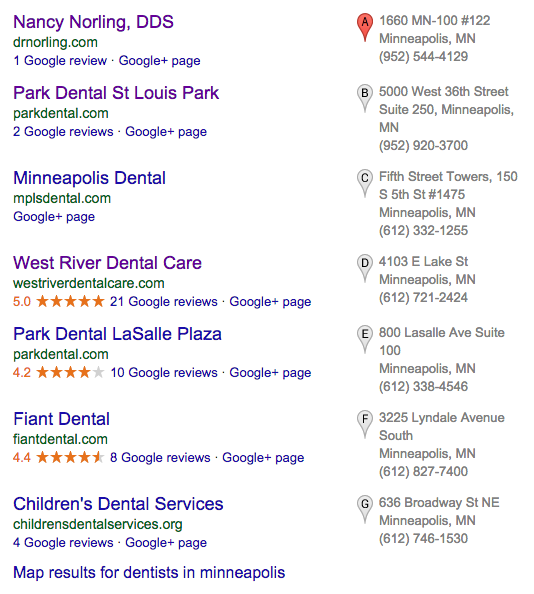
2. Identify Competitor Backlinks
As many of you know, a main component of Google’s ranking algorithm is based on backlinks from external sites. No longer do large amounts of spammy backlinks help rank a website, but relevant and authoritative backlinks that truly show that two sites are linked together. And in Local SEO’s case, relevant local backlinks truly help a website’s cause as well.
It’s a great idea to analyze your competitors’ backlink profile in order to get an overview of a few key points:
- How many backlinks from separate root domains do your competitors actually have? (1-10, 11-20, etc.?)
- How competitive really is the local market you’re in? You’ll be able to tell by the type of backlinks your competitors have obtained (are they spammy links, high quality content related links, or just local links they got from the city business directory?)
A few tools I use to examine top competitors’ backlink profiles
You can use one or all three, I tend to take a look through them all to see if one is missing some links that the other has. Moz seems to be the most helpful to me at least for this part of the analysis just because everything is easily broken down:
Check all of the top competitors and record your findings including DA, PA, and number of root domains, including number of follow links.
Just in example, let’s take a look at the first local result above, www.drnorling.com, in Moz OSE:
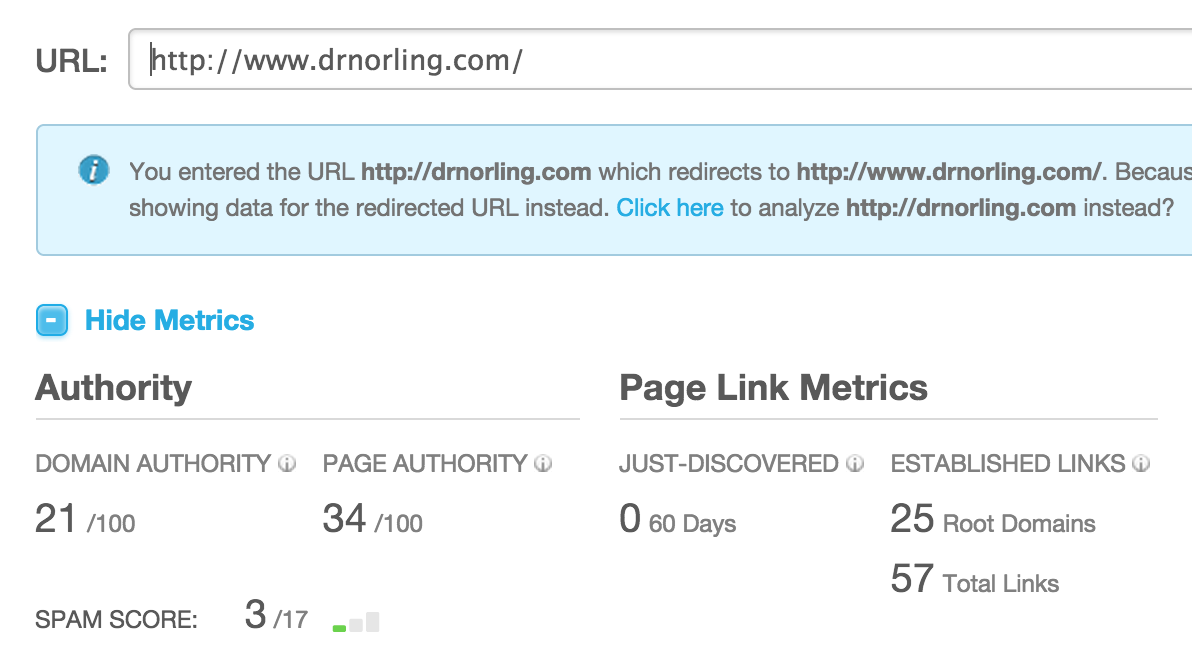
Things I’d note:
Domain Authority – after checking many of the top 7 separately, domain authorities seem to be in the 20-35 range typically
Page Authority: This particular landing page has a higher PA than many of the other competitors at 34
Links: Has links from 25 root domains – higher than most of the other competitors in this local niche
Glancing at the top 5 follow links to this homepage, it looks like top of their link profile consists of a couple higher authority directory listings and 3 press articles from pretty well known Minneapolis publications (high quality local and relevant links)
Although this is barely enough information to base an entire campaign around, it does give you 1 very insightful point from my view: You now have a broad view of the authority and backlink combo that a top ranked local dentist website in this area has.
However, remember westriverdentalcare.com from the Reviews chapter?
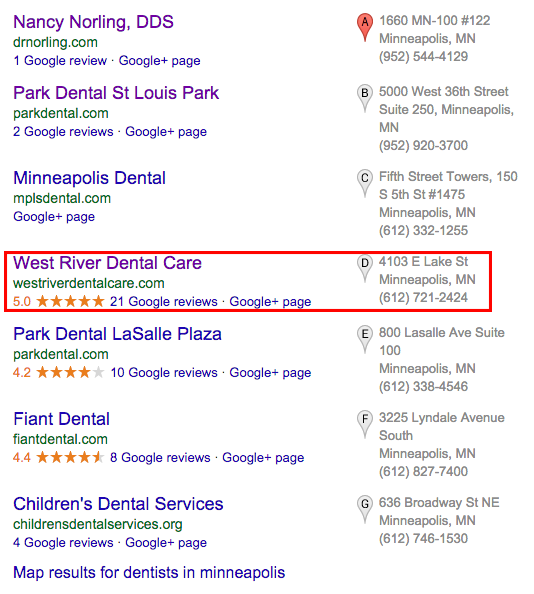
If we go back up to my original post about how in that particular 7 map pack, westriverdentalcare.com from my point of view seemed the most likely for a visitor to click on.
No it wasn’t a top dog, but it was right in the middle of the map pack with 21 reviews and a shiny 5.0 in Gold Stars. Clickbait waiting to happen.
Well they only have a Domain Authority of 13 and Page Authority of 22 with 2 Root Domains.
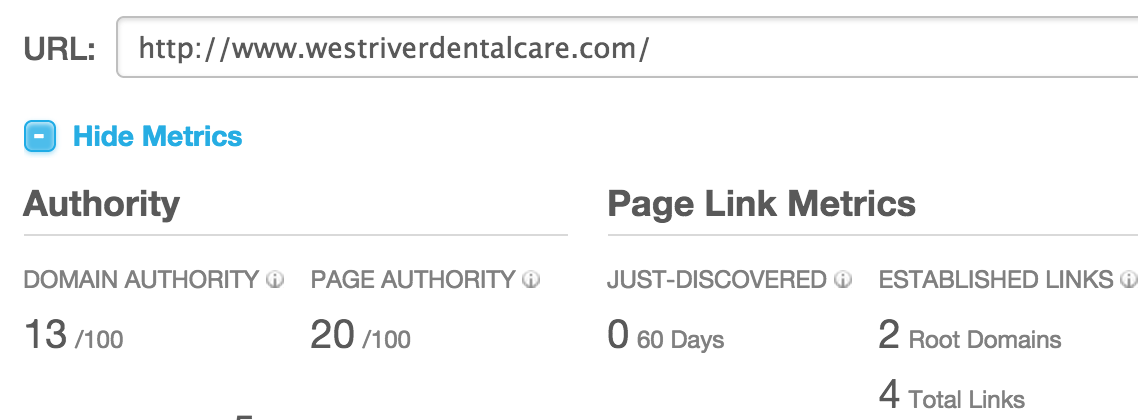
What does this say? That this map pack really is up for grabs if you put some work into your campaign. There’s more factors than you can count that go into the Local algorithm. It’s not just links, not just reviews, not just on page, it’s a combo of everything that helps you win at Local SEO.
3. Competitor Traffic Analysis
Another fantastic thing that software tools today can do is analyze the traffic your local competitors get and which organic keywords they’re getting it from. I love SEMrush for that reason. The tool is fantastic and allows you browse through piles of information that can help you get an insight into your competitors.
A few of things I like to compile information on:
- Competitor monthly organic traffic over the past year
- Top keywords competitor ranks for
- What percentage of total traffic does each keyword drive to the website
This information is incredible and really allows you to form a strategy of your own if targeting similar keywords.
Let’s do an example again with westriverdentalcare.com. Head to SEMrush and type in the URL, you should get the overview tab to display the URL overview upon searching.
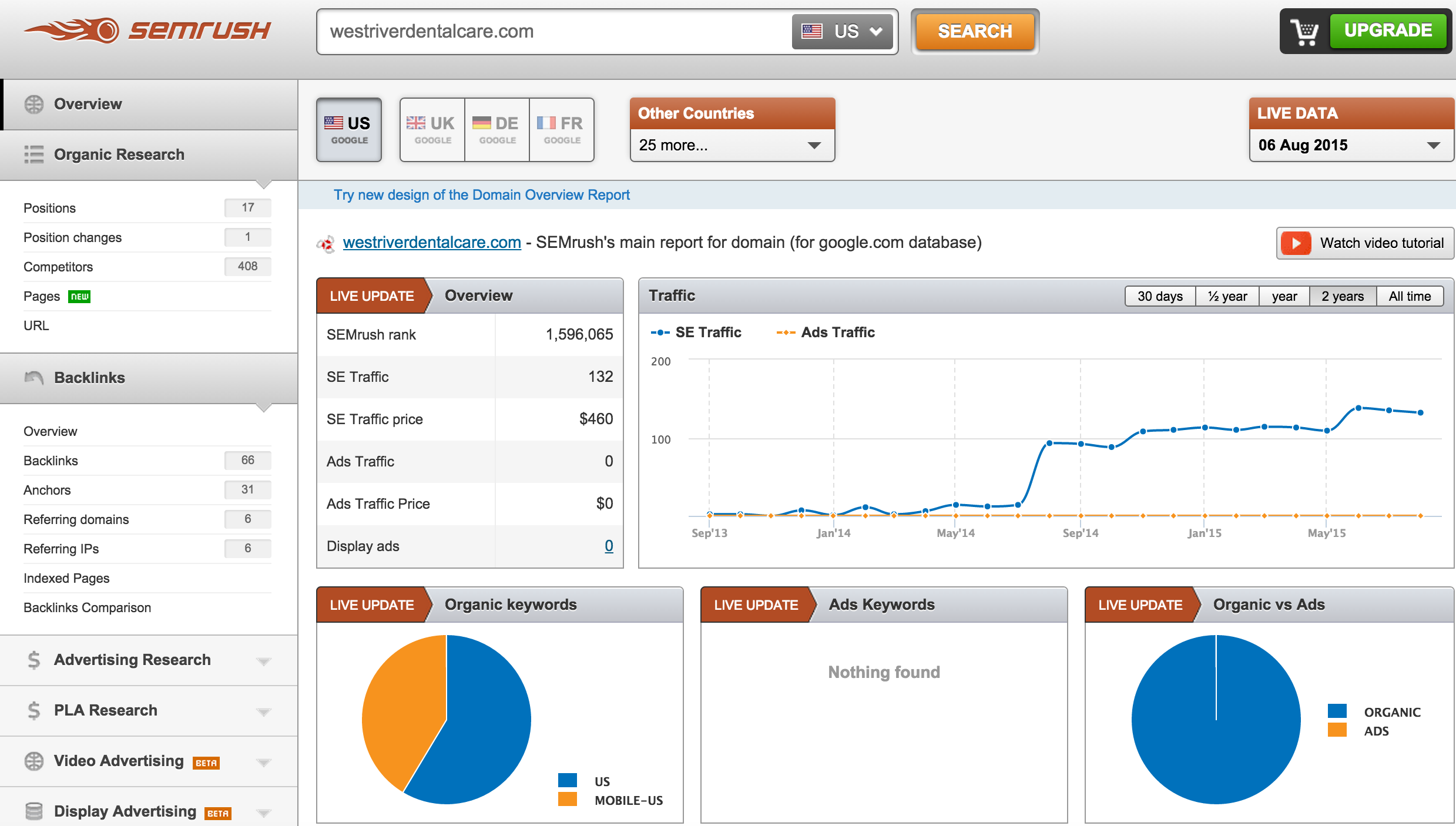
Right away you can take away a few key factors: the average monthly traffic the site brings in, difference in organic vs paid traffic, and difference in traffic between desktop and mobile traffic.
Scrolling down a bit more you’ll be able to see their top ranking organic keywords:
It appears that west river dental gets the majority of their traffic from branded keyword searches for their actual dental location, as most of the local keywords they’re hanging on the bottom of the top 10.
Click on “full report” link at the bottom and you’ll be able to get a more in depth view at their local keywords.
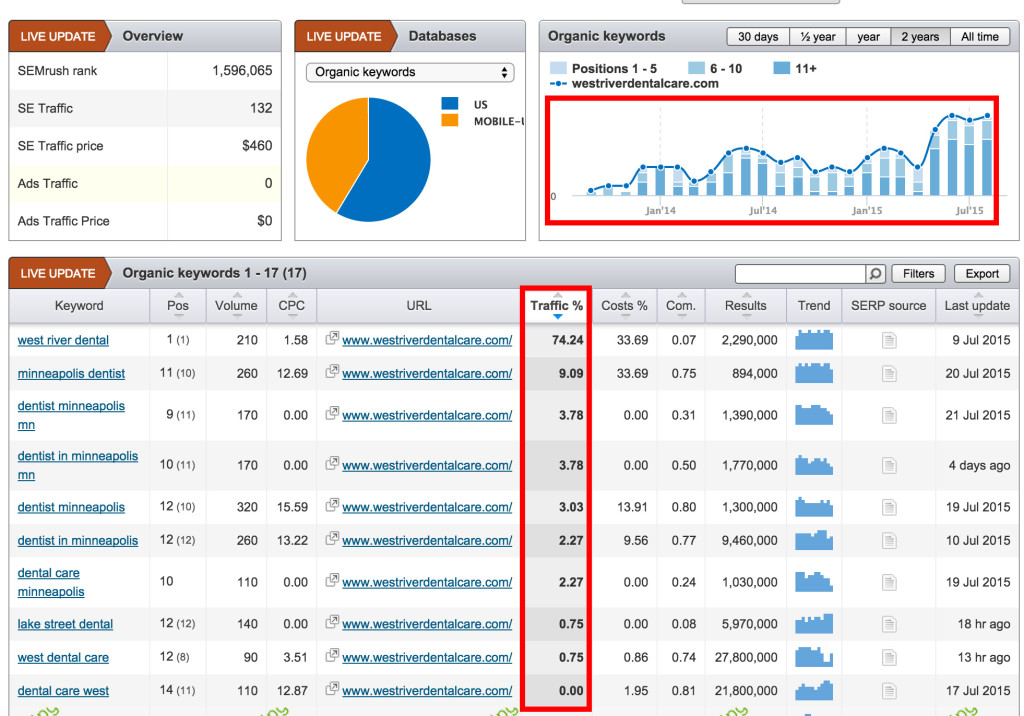
You can see that 74% of West River Dental’s traffic comes from their #1 position for west river dental, which has 210 monthly searches. The other 25% of traffic looks to be coming from local search terms in Google. Those are the terms you’d want to target.
There’s so much more information that SEMrush is loaded with including backlink reports and site audits, but we’ll save that for another day.
For a real insight into the competitor research you can do with SEMrush I suggest checking out a few of these resources:
22 Stealth Competitor Research Tactics with SEMrush – by Robbie Richards
5 Ways SEMrush makes me look like a SEO Wizard to Potential Clients – by Andrew Shotland
4. Competitor Citation Analysis
Running a quick citation analysis on your top competitors is another good way to feel around and see where your business currently stands in relation to them.
Should you be getting every single citation that your competitors have? Not necessarily. Some may be spammy, some may be unrelevant, and some may just not apply to your particular business in general. This is where you need to know which ones will help and which won’t. I’d generally stick to the top citations that appear to see if you’re missing any of those.
I highly recommend using Brightlocal’s Citation Tracker. You can run the citation tracker on your business and then go to the “Potential Citations” tab where it will give you a list of potential citations that you could obtain and which ones your top 5 competitors in maps already have.
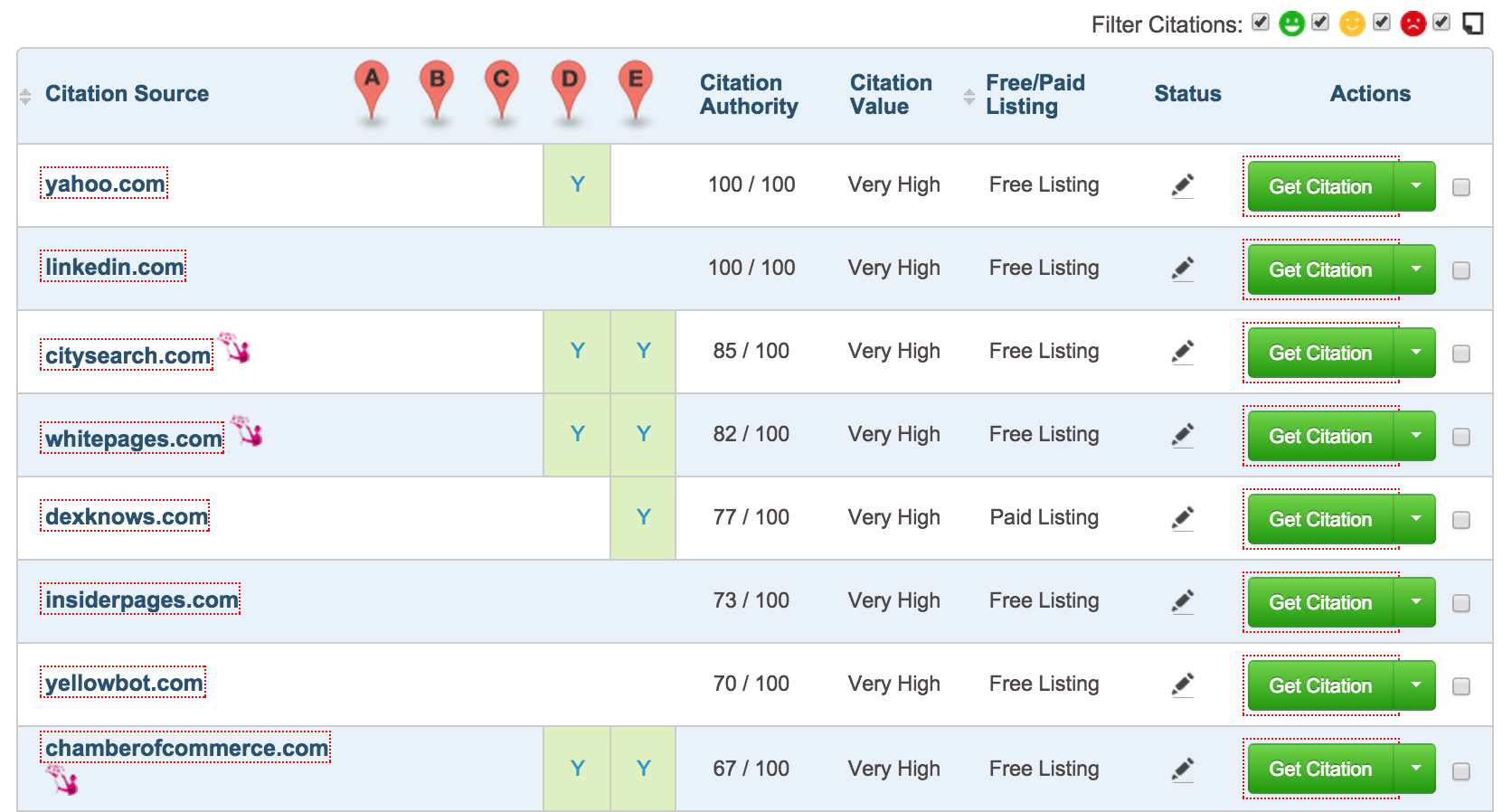
BrightLocal’s citation tool is a lifesaver.
Some other options are to run a free scan on each competitor at Yext.com or on Moz Local to see where they stand.
Record your results and make a decision after that on which citations will be priorities to obtain for your Local SEO campaign.
5. Competitor Review Analysis
Reviews matter…and it’s a good idea to see where the top competitors of yours are at.
I would always shoot for at minimum for 10 reviews to start a Local SEO campaign either way.
In most industries, 10 solid reviews will do some justice. However, there some local categories that are ultra competitive and will require a higher quantity of reviews to stand out.
In particular, the restaurant and lodging industry. Just in example, Googling San Diego restaurants will return a top 10 results with between 100-400 reviews each with solid ratings over 4 stars.
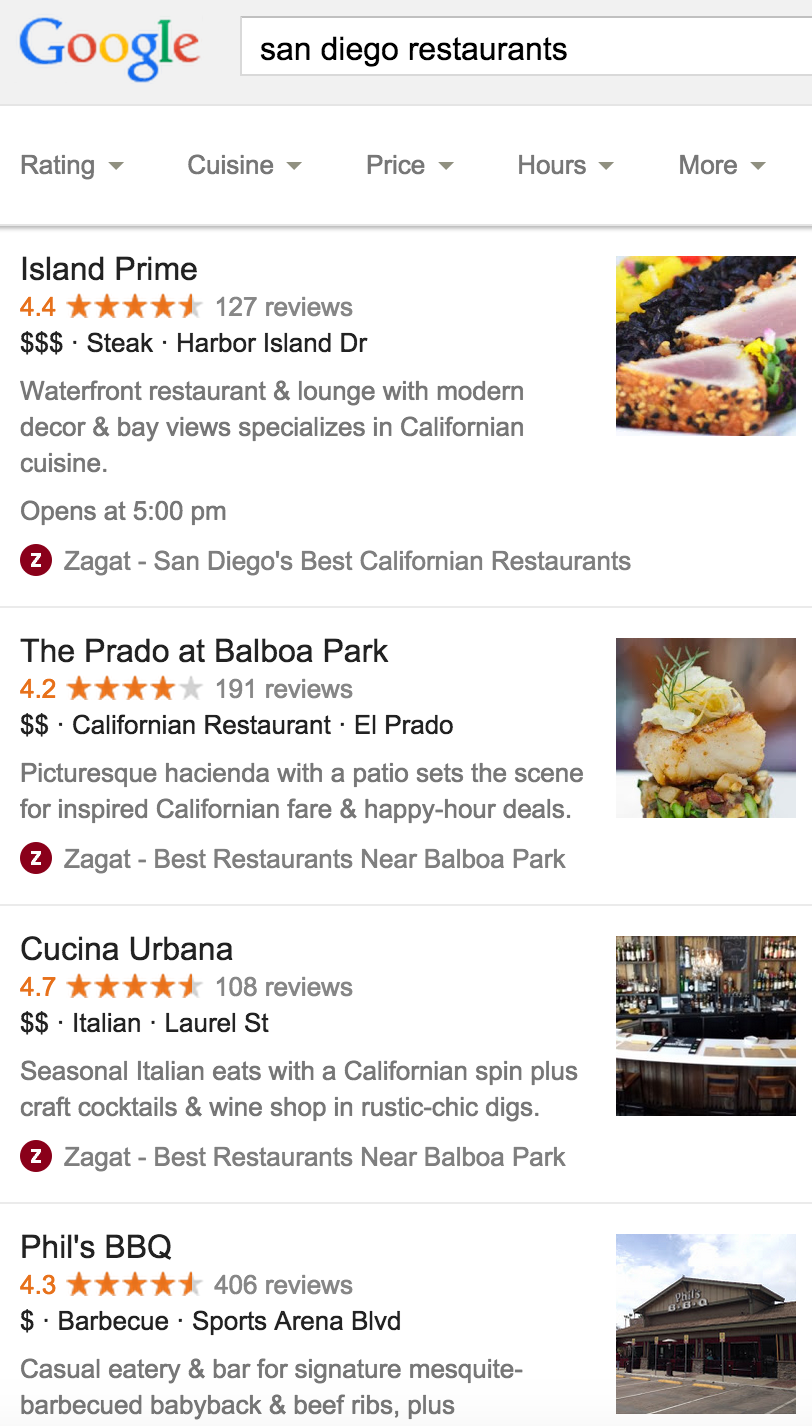
That’s a tough mark to beat if you’re new in the industry and will take hard work and dedication in the reviews game.
However, most of the time you’ll probably be pretty well off at the 10-20 mark in the Google reviews game.
The key is to nail down your reviews strategy, be consistent and hammer away until you’ve reached your goal.
Resources Mentioned in Chapter 7
Moz Open Site Explorer – backlink tool
Majestic SEO – backlink tool
SEMrush – backlink/traffic tool
Ahrefs – backlink tool
SEMrush Review: 22 Stealth Competitor Research Tactics – by Robbie Richards
5 Ways SEMrush Makes Me Look Like a SEO Wizard to Potential Clients – Andrew Shotland
BrightLocal CitationTracker – competitor citation analysis tool
Chapter 8: Ultimate List of Local SEO Tools
My goal for this last chapter is for it to be an epic and ultimate list of tools and resources that Local SEOers use on a regular basis to help with their campaigns.
Hopefully this can help everyone out there no matter if you’re an agency working with clients or attempting local search optimization for your own business.
For all those experienced in the field, if there are certain tools or resources that are missing from the list that you believe are extremely valuable to the process, please leave a comment so we can get them added to the list!
Please Note: This list is in no particular order and includes prices at date of publication – everyone’s preferences on what tools they use are different (There are no affiliate links here)
Business Citation Analysis Tools
WhiteSpark Local Citation Finder – Free to try, then starting at $16.67/month for a small business up to $83.33/month for Enterprise Version
BrightLocal Citation Finder – Free 30 day trial, starts at $19.99/month for single business up to $64.99/month for SEO Pro version
Moz Local – Free to run analysis of top directories – paid building service
Yext Powerlistings – Free to run analysis – paid building service
Universal Business Listing – Free to run analysis – $50-$195/month listing management service
NAPtune Listings – Free to run analysis – paid building service
Synup – Free citation analysis – paid management service
Local Citation Building & Management Services
Moz Local – $84/Year for Major Data Aggregator submissions
BrightLocal Citation Burst – $3 per listing or $2 per listing with bulk credits
WhiteSpark Citation Building – $4 per generic listings, $5 per niche listing – bulk discounts available
Yext Powerlistings – $199 – $999/year for citation submissions/management
NAPtune Listings – $50 for basic local up to $195/month for management
Universal Business Listings – $79-$399 year for management
GoDaddy Get Found Service – First year starting at $11.99/month
Synup – $2 per listing on free plan, $2/month upgrade for pro plane and per listing cost drops to $1.50/each
Schema Tools & Resources (Free)
Schema Generator Tools on SEOchat
Structured Data Testing Tool – by Google
Google My Business/Google Plus Tools & Resources
Blumenthals Business Category Tool – Free
BrightLocal Google+ Local Wizard – Free 30 day trial available, then starting at $19.95/month
51 Blocks Local SEO Tools – Free
Google Maps Embed API – Free
Google Map Maker – Free
Review Tools & Services
Review Handout Generator by WhiteSpark – Free
ReviewTrackers – Starting at $49/month for single location
BrightLocal ReviewFlow – Free 30 day trial, then starting at $19.95/month
Get Five Stars – Free 15 day trial, then starting at $29.95/month
Reputation.com – Starting at $400/year
ReviewPush – Free 30 day trial, then starting at $29/month
Free Review Monitoring – Free for 3 locations (for now)
Review Trail – offer a Free version, $10/month for upgraded version
Yotpo – Lite version is Free with minimal features, $25/month for starter plan
Local Search Rankings Tracking Tools
BrightLocal Rank Tracker – Free 30 day trial; then starting at $19.95/month
Local Rank Tracker by Whitespark – Starting at $5/month for 10 keywords
SERPs Google Plus Local Rank Tracking – Free 30 day trial; then starting at $497/month
Moz Local Rankings – Free 30 day trial; then starting at $99/month
Places Scout – Free 14 day trial, then starting at $19.99/month
AgencyAnalytics.com – Free 14 day trial, then starting at $49.99/month
SEMrush Position Tracking – Starting at $69.95/month
Authority Labs Rank Tracking – Free 30 day trial – starting at $49/month
UpCity Rank Tracking – Starting at $50/month
Ranktrackr – Free 10 day trial; then starting at $15.20/month
GeoRanker – Free Account with Top 30 keywords – Pro plan starting at $99/month
In the End
Overall, I hope this local SEO guide can give you a great jumpstart on finding the most dominant Local SEO strategy that works for your business or client. There’s an endless amount of resources out there and I hope I was able to round up some of the most valuable ones into this guide.
I know it’s a long read, so I did make this guide downloadable in PDF form if you want to continue or go back at a later date.
Click Here to Download Local SEO: The Definitive Guide as a PDF
Please leave a comment if you have any questions and definitely give feedback on any resources you feel that I left out!

